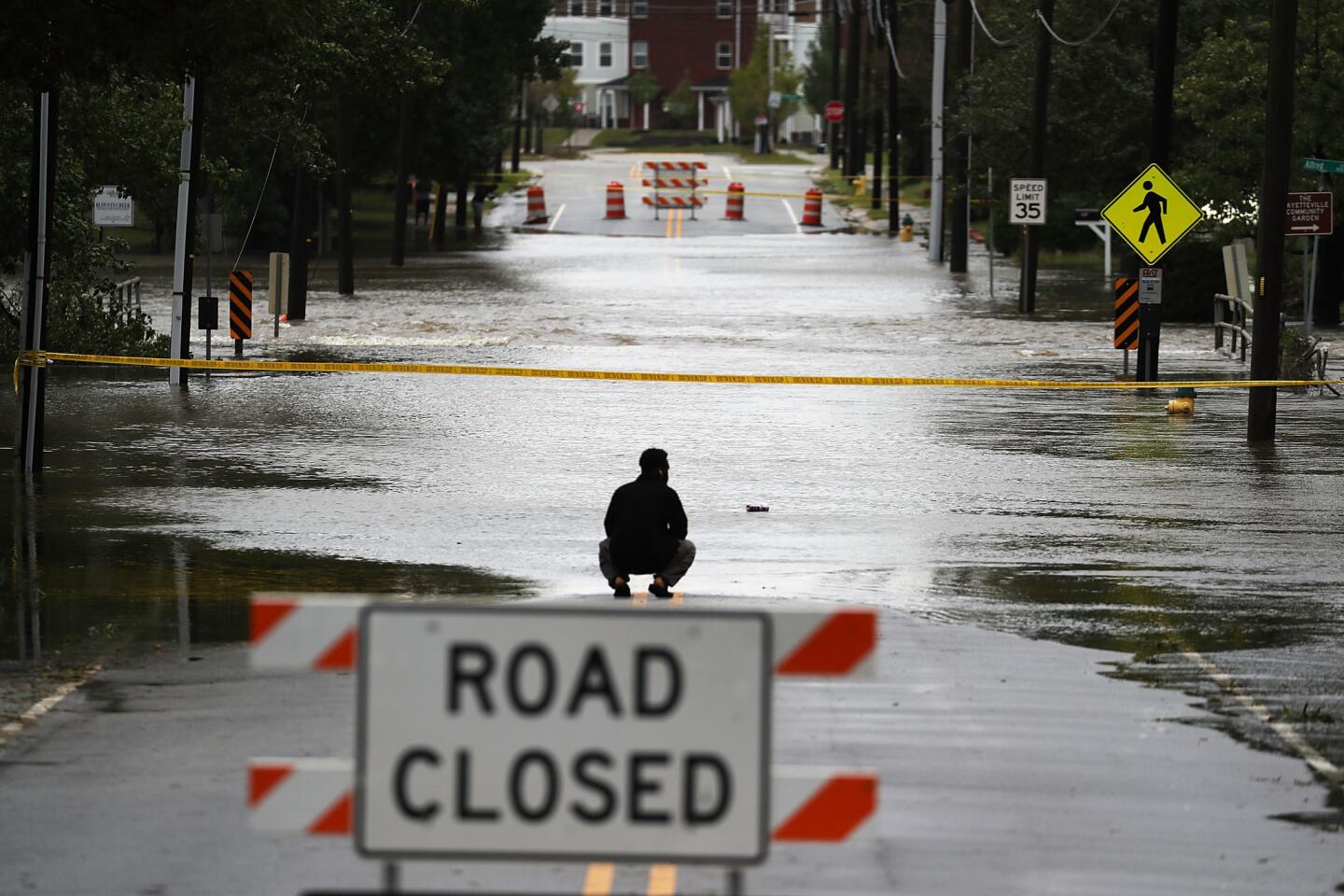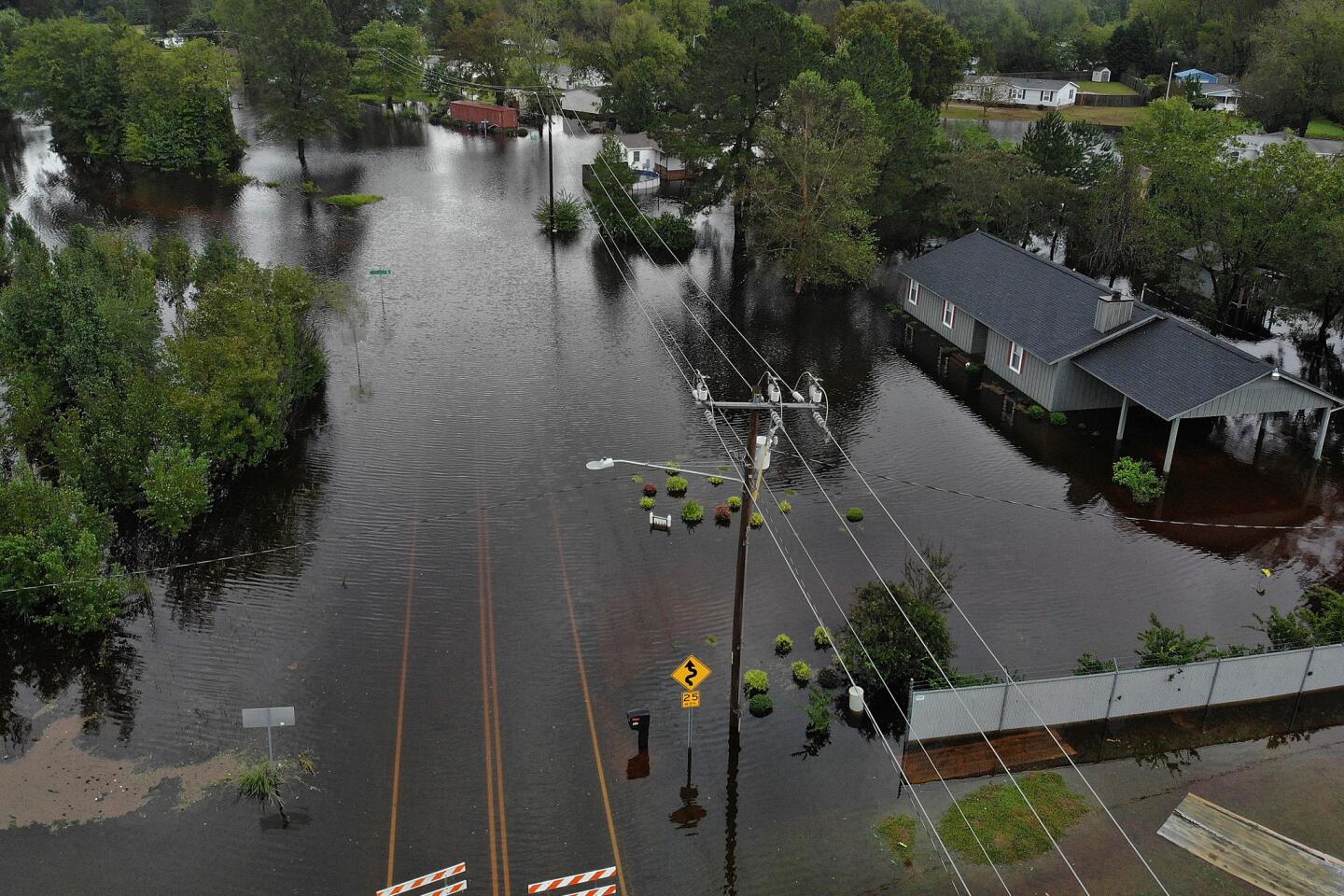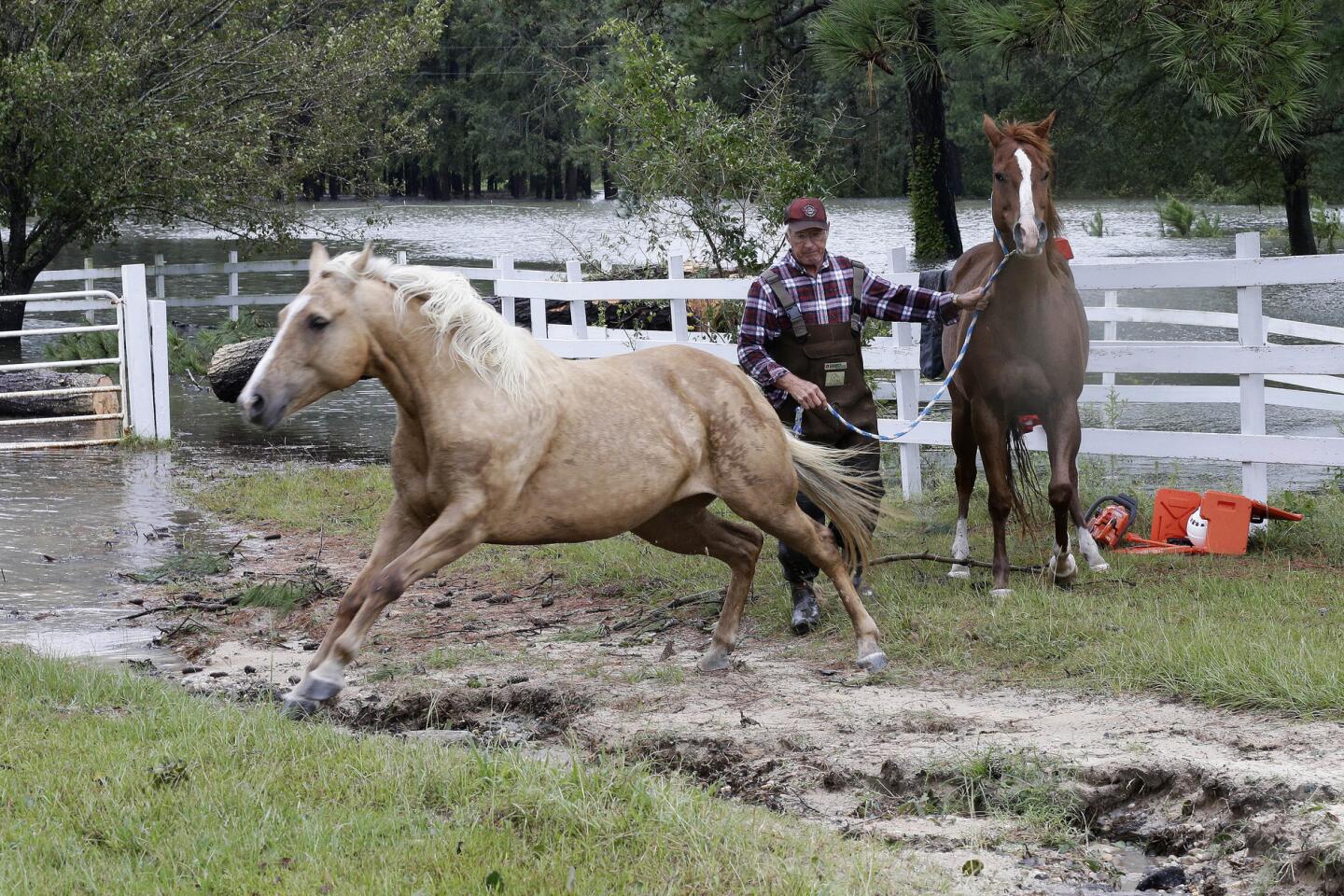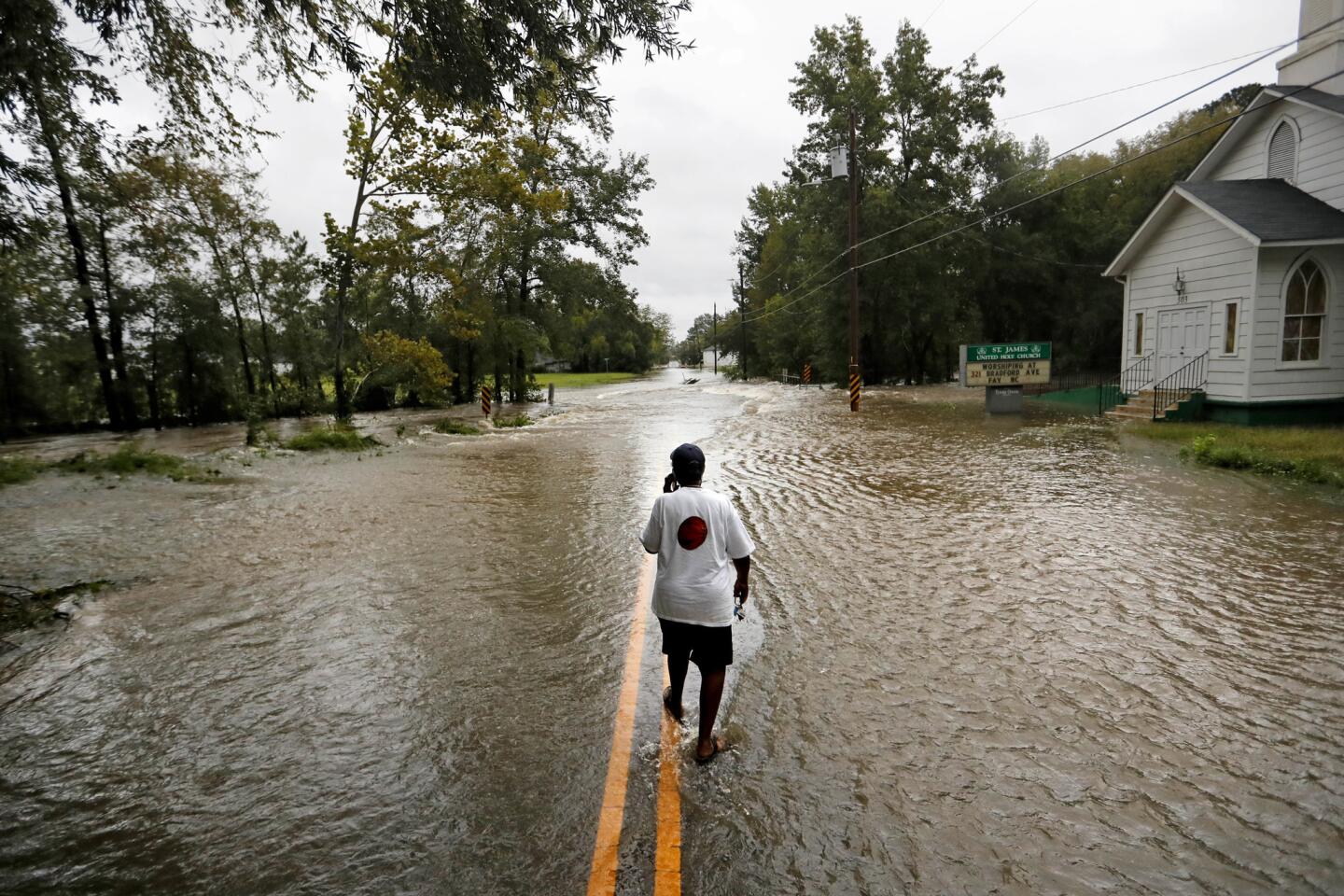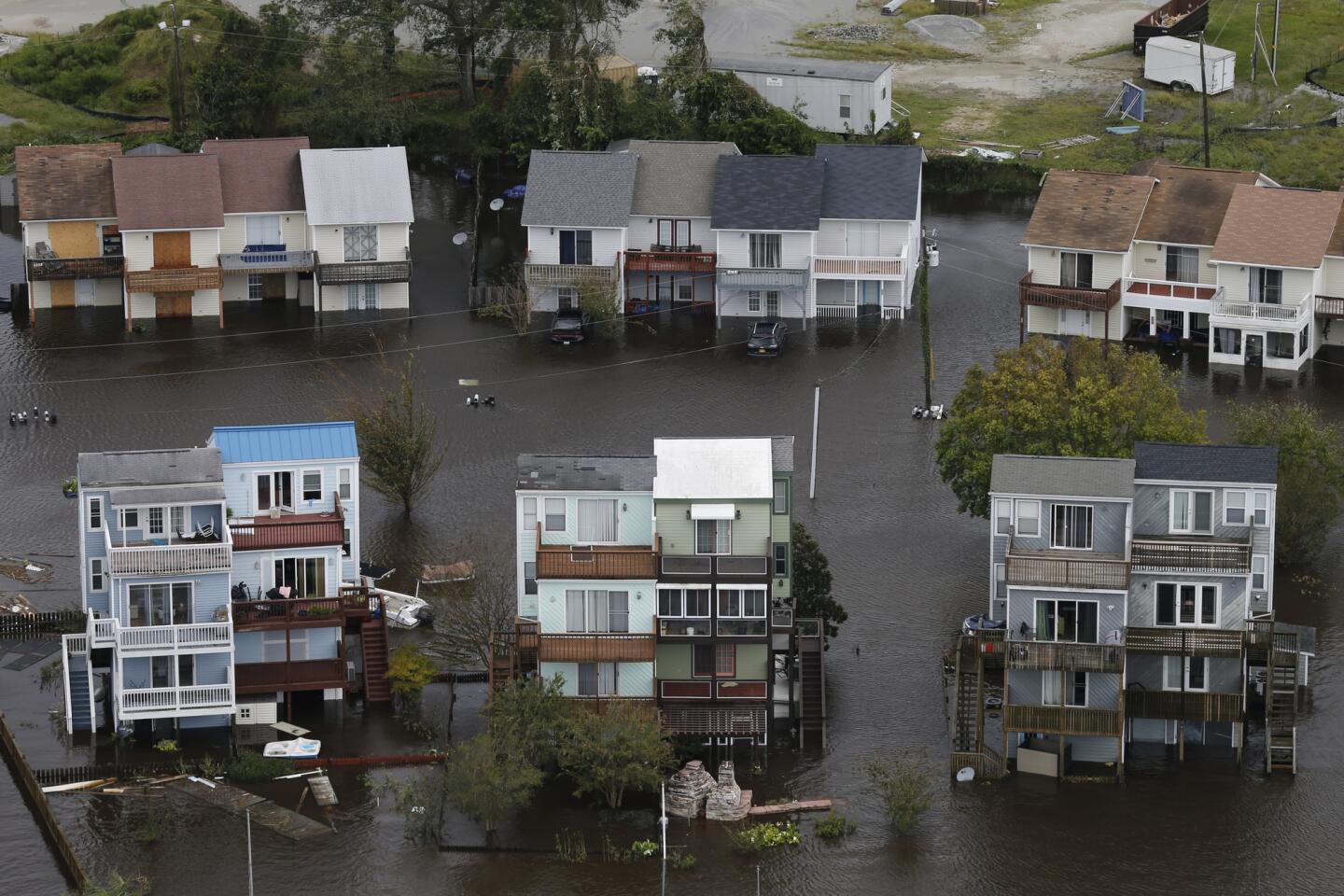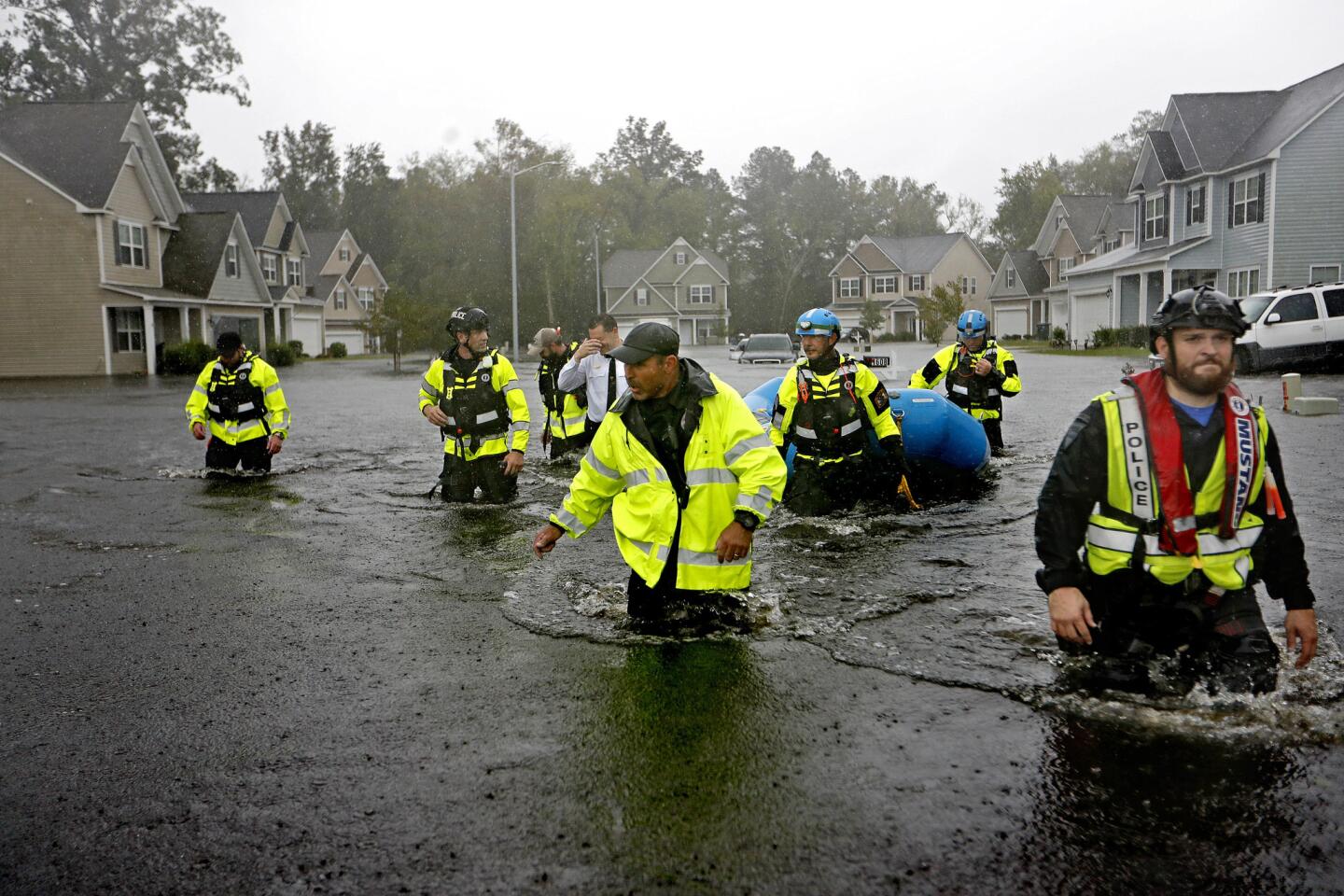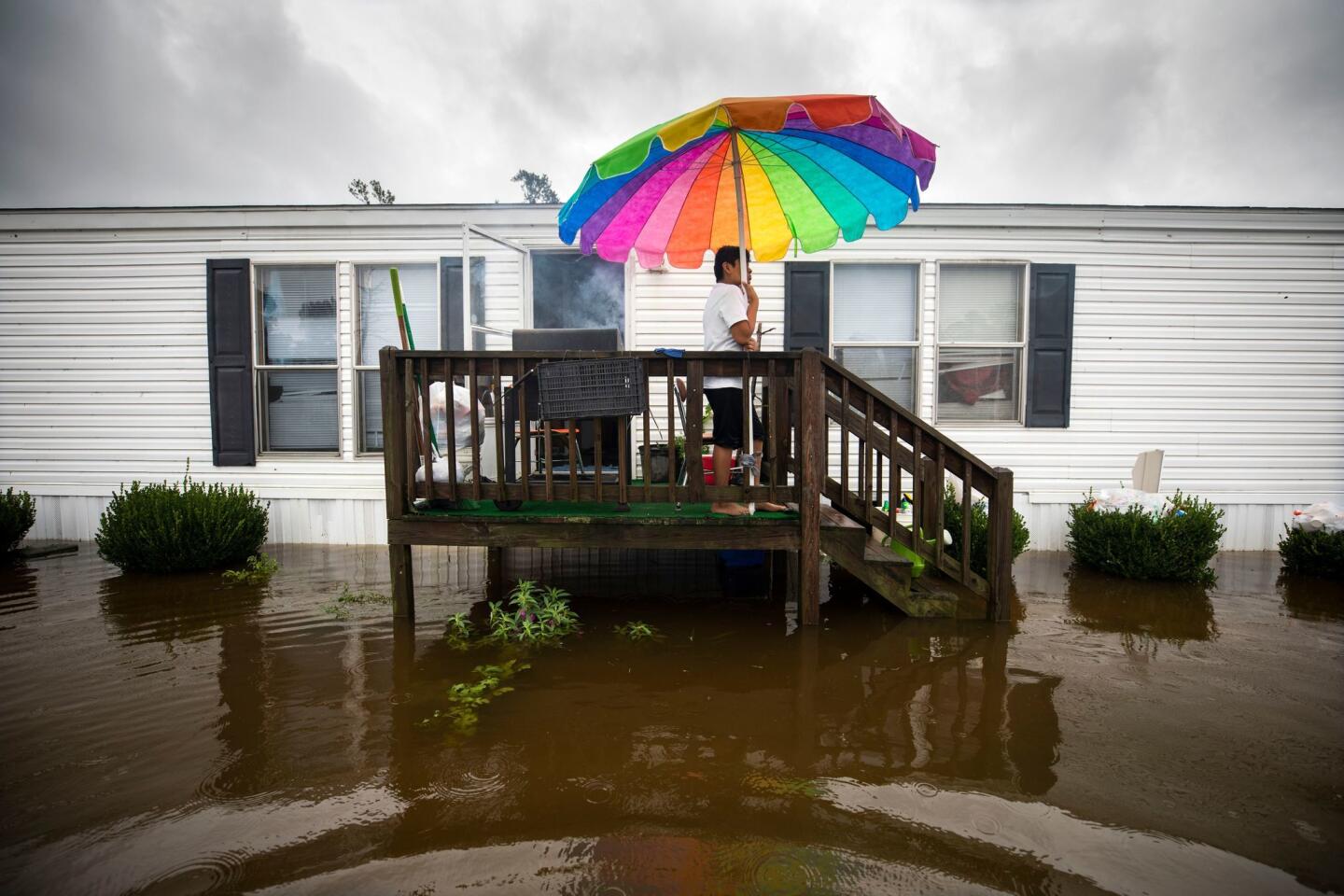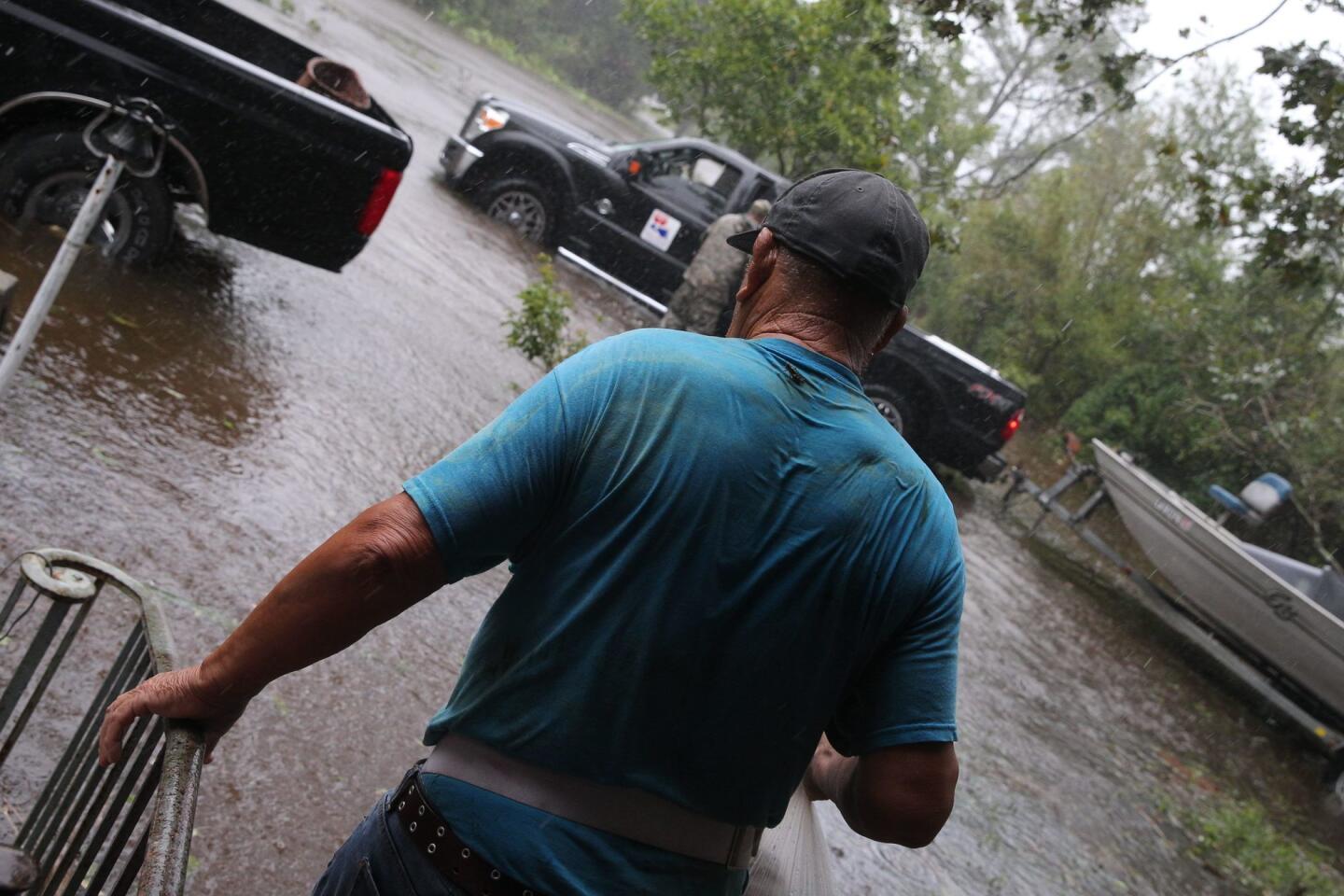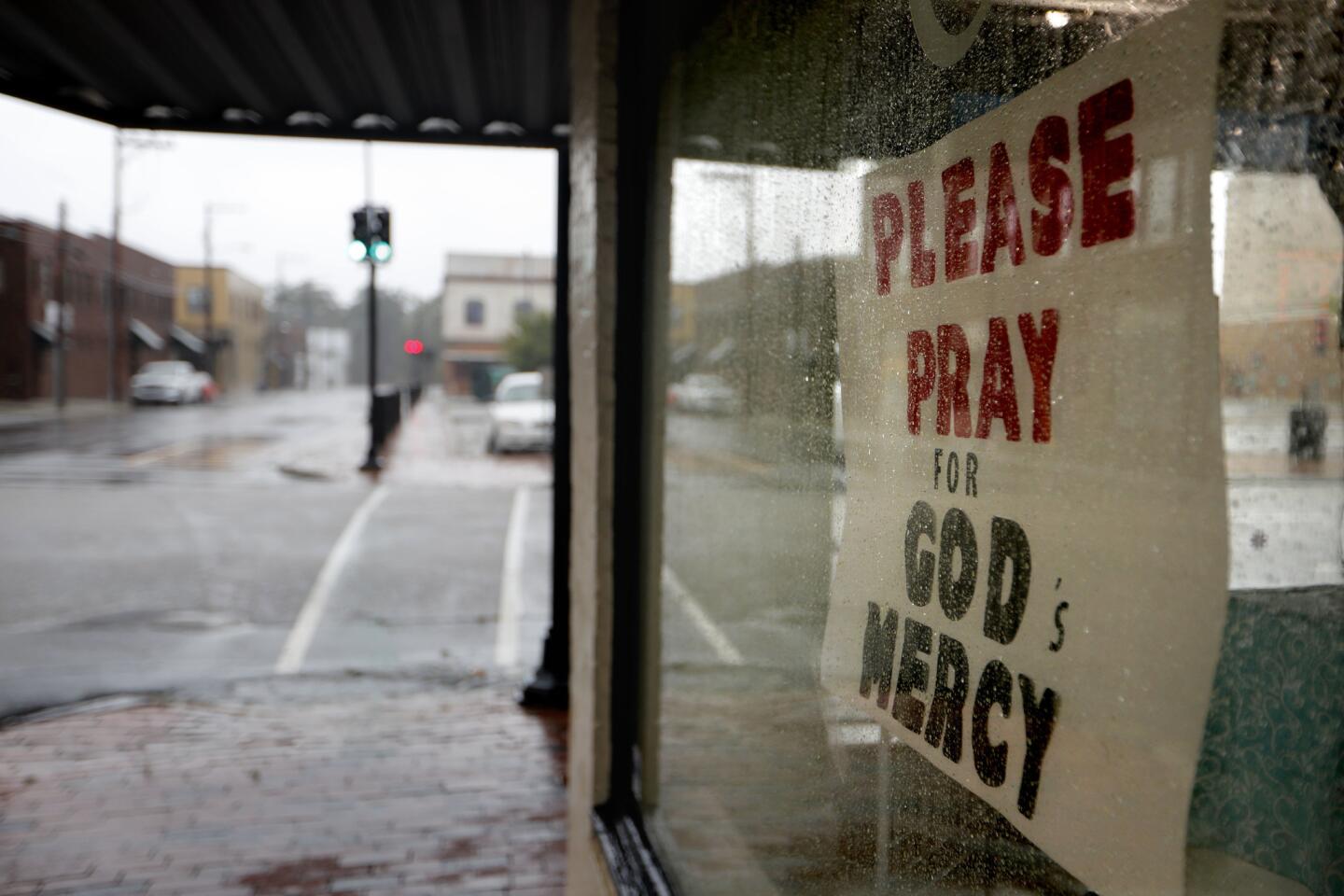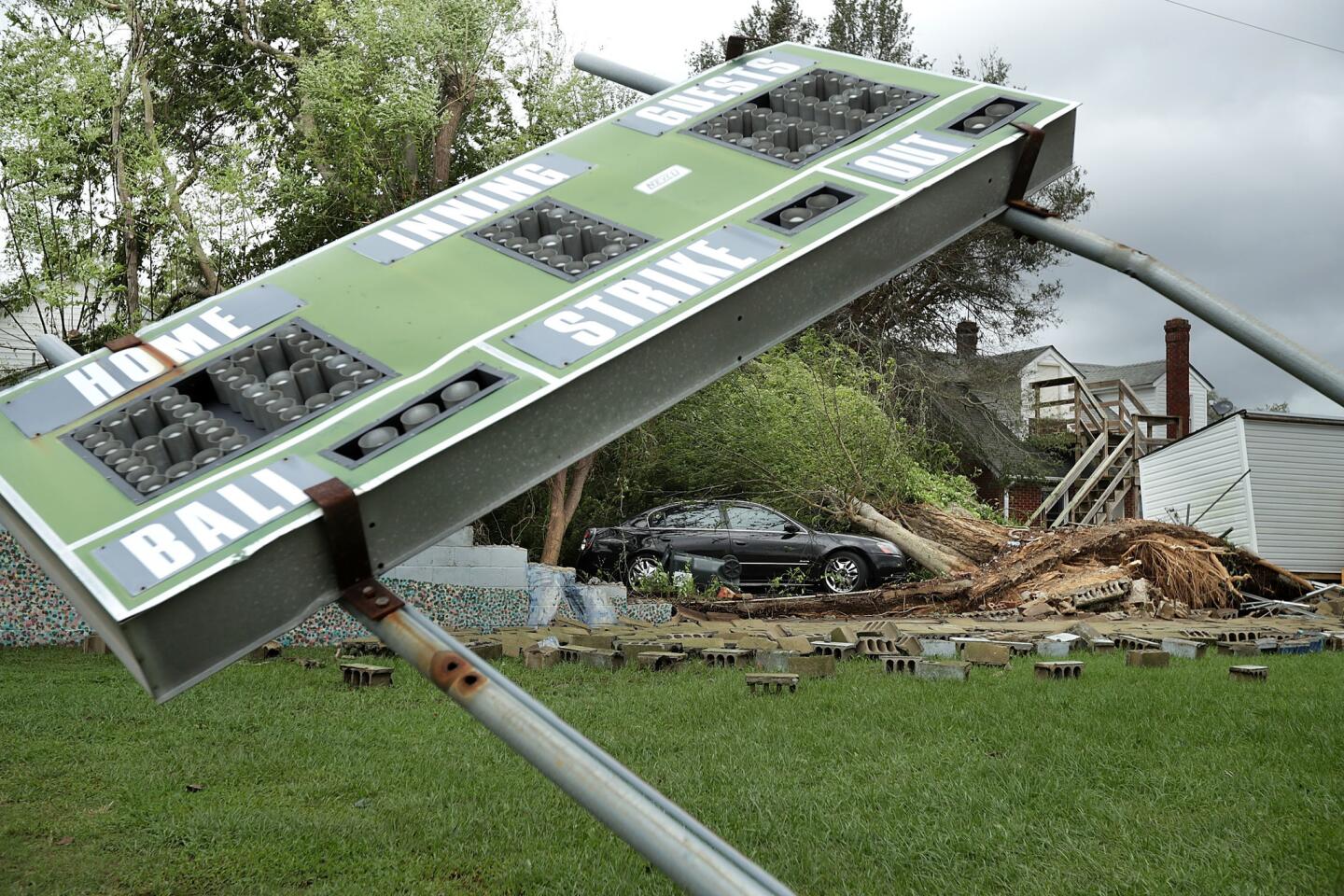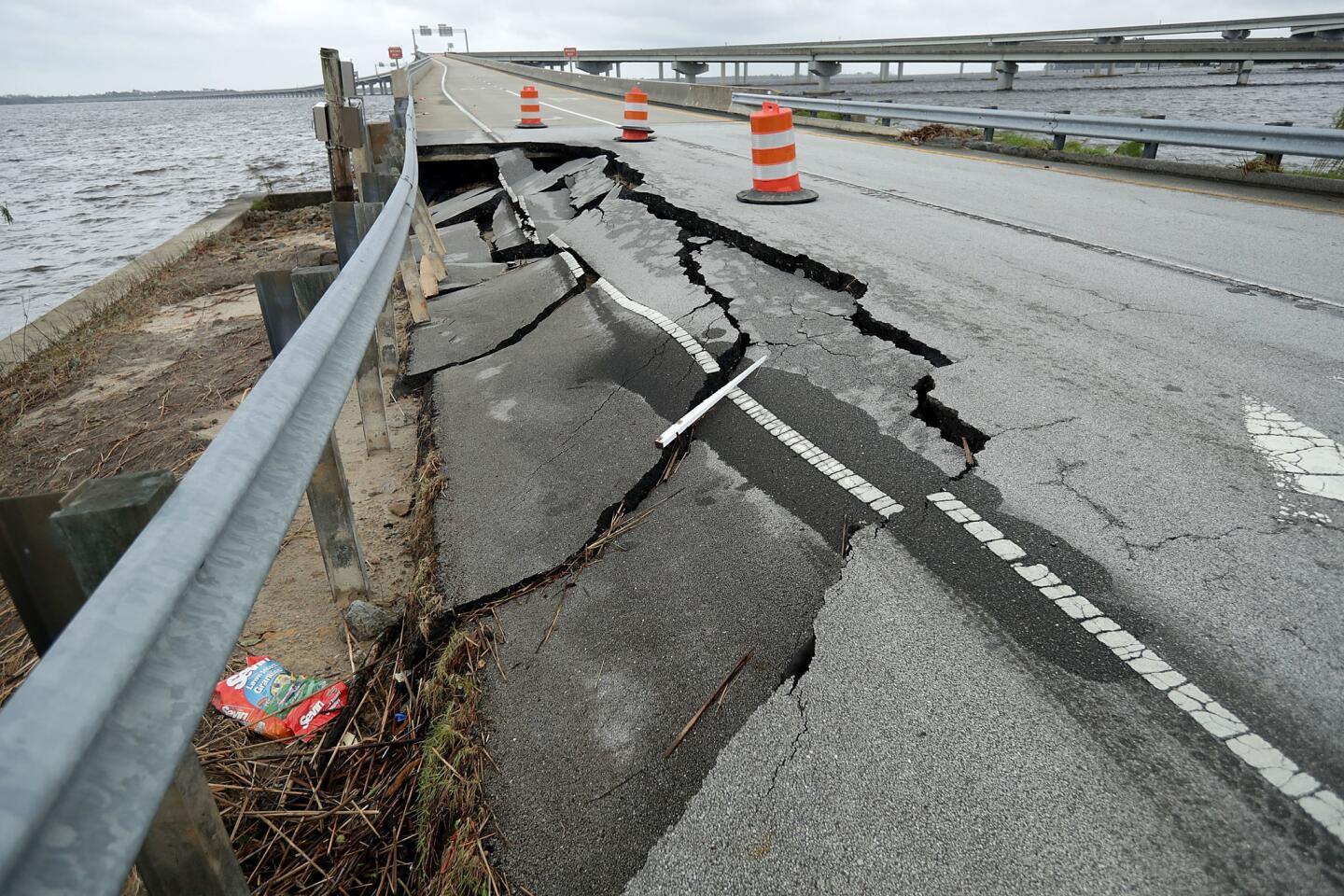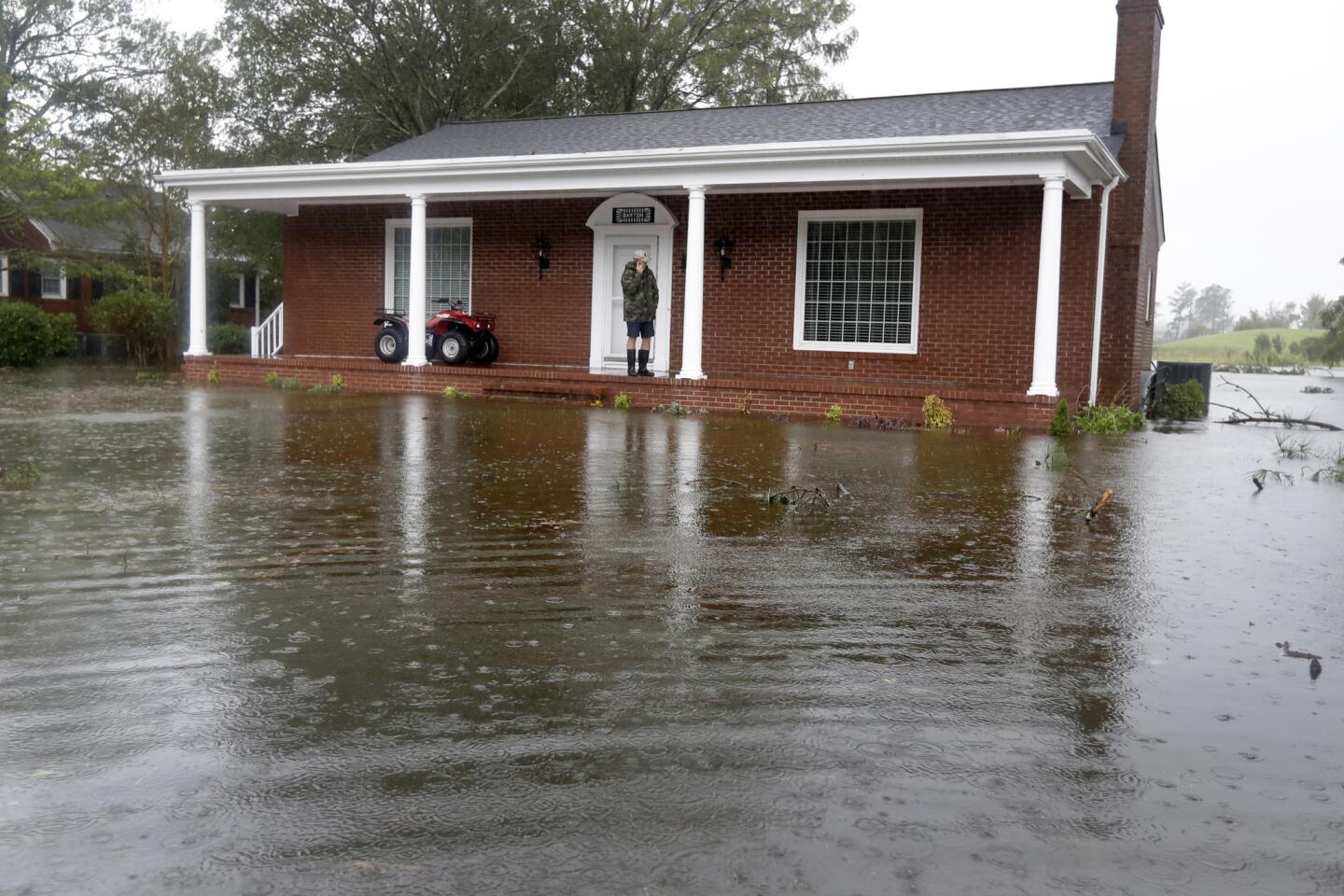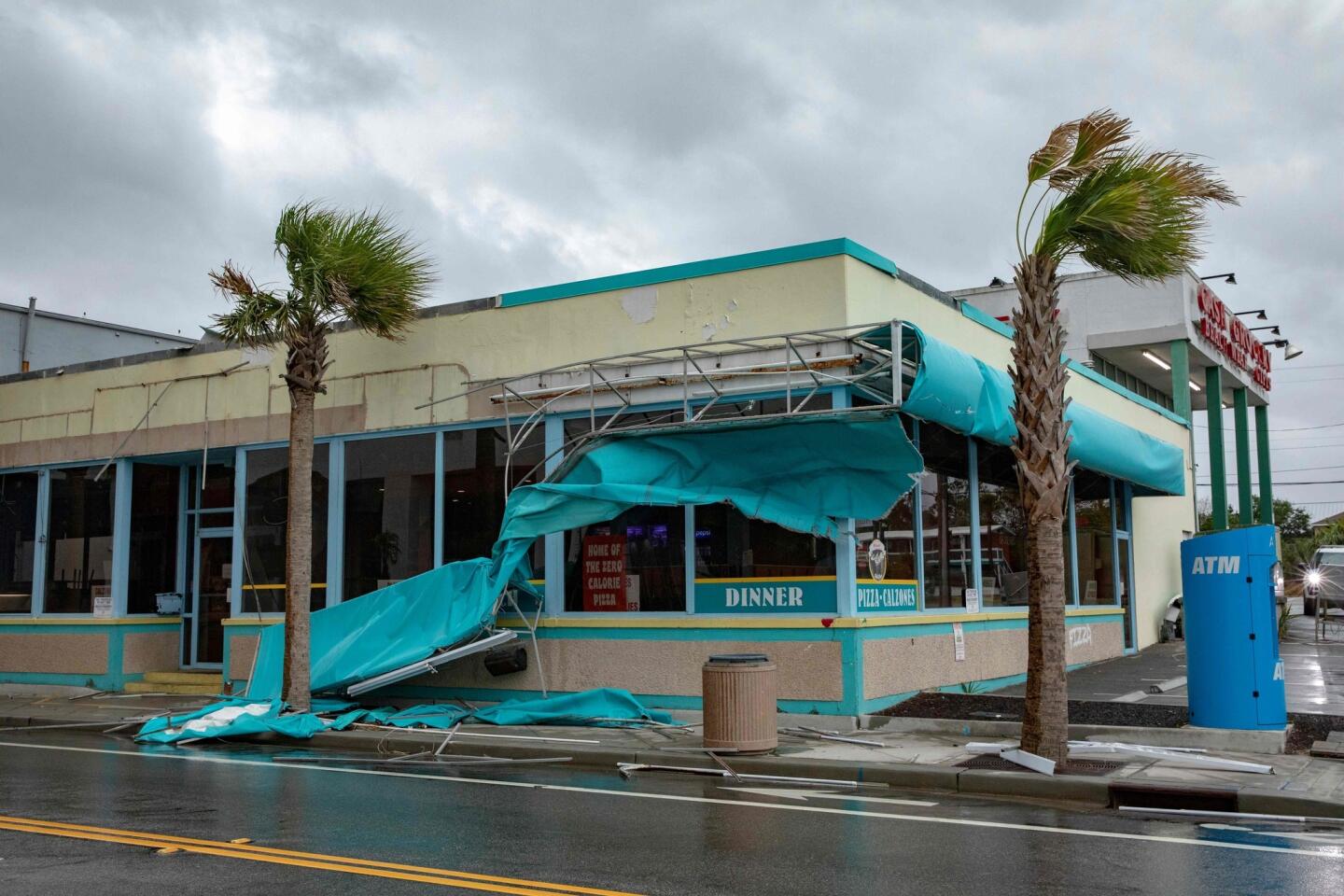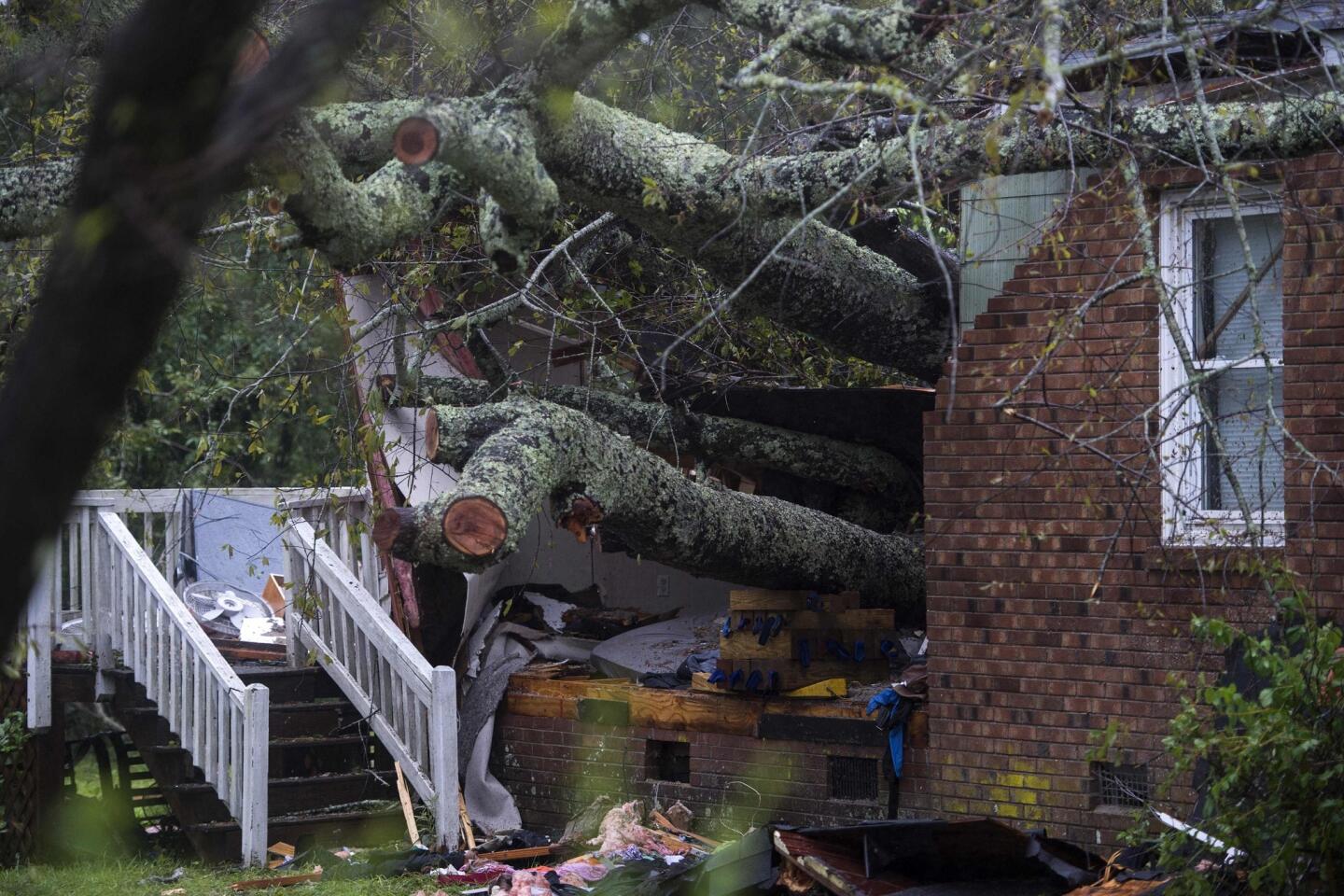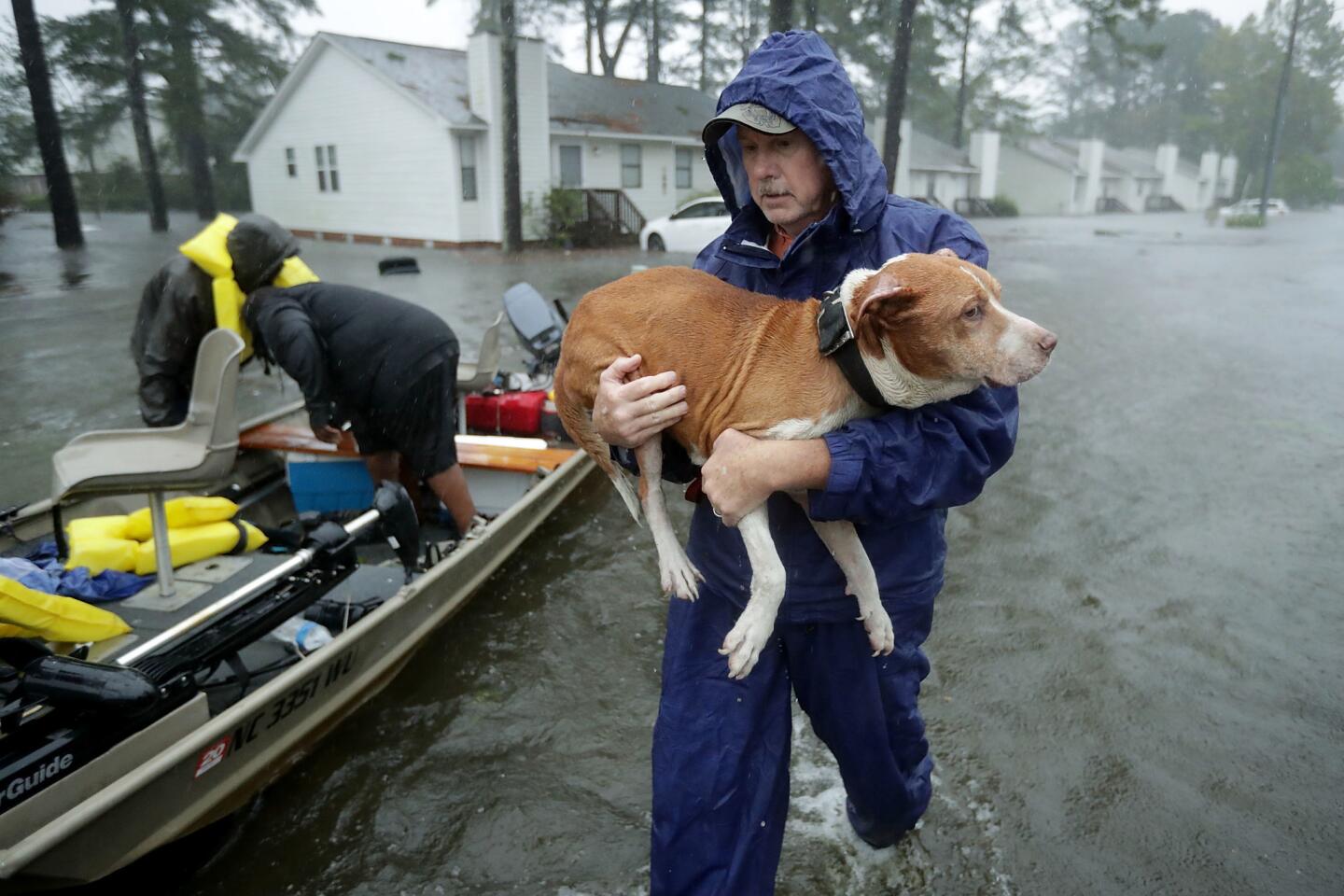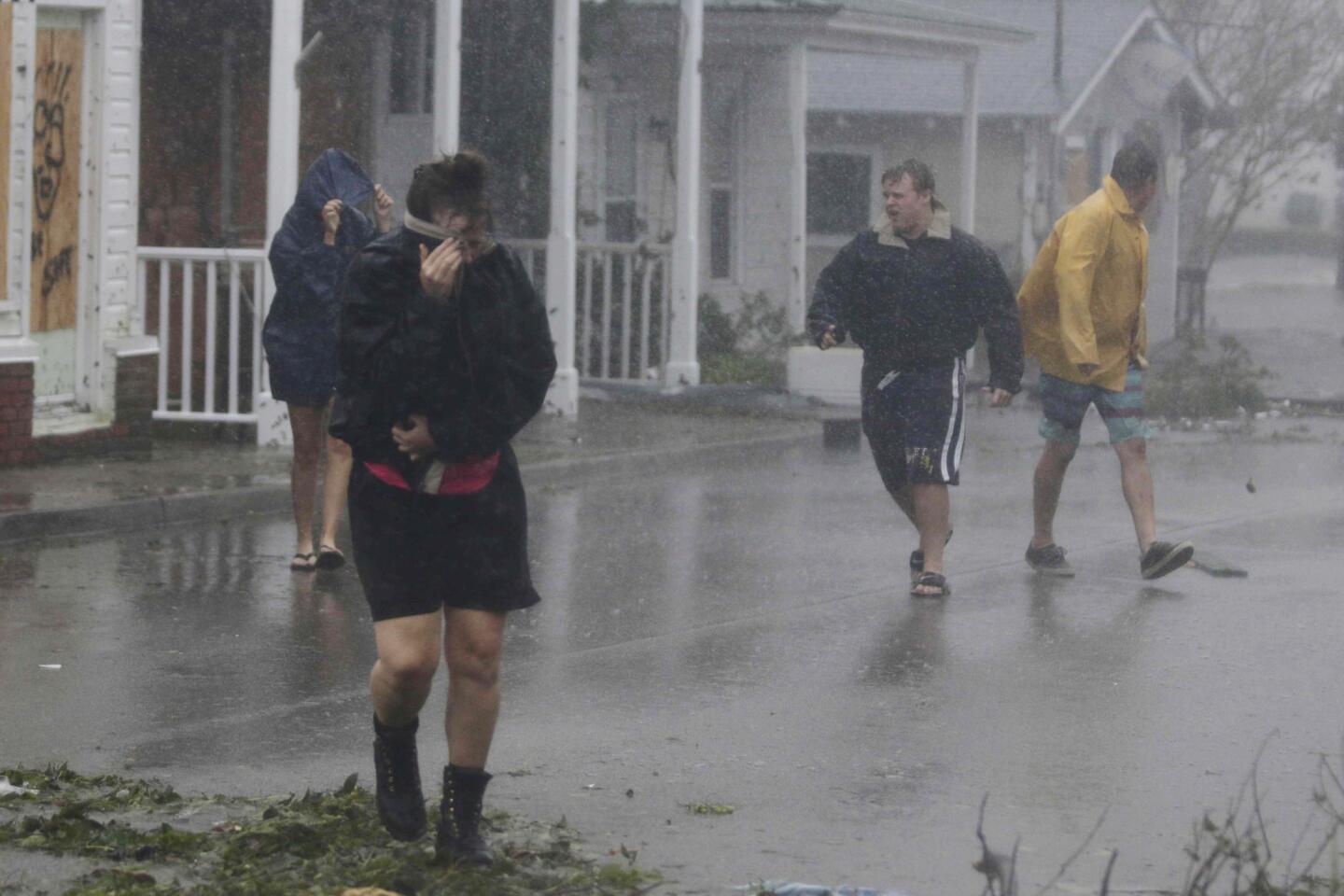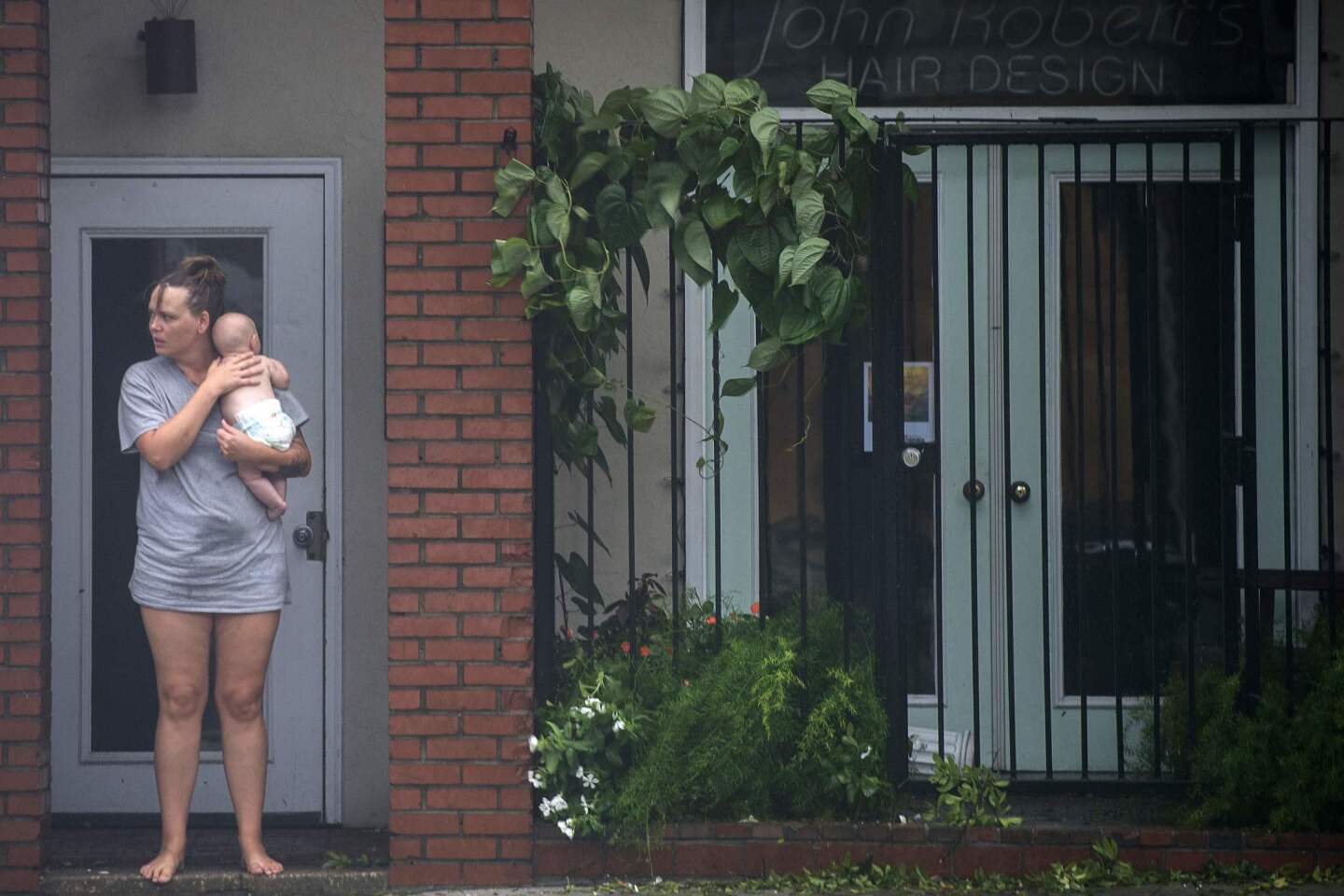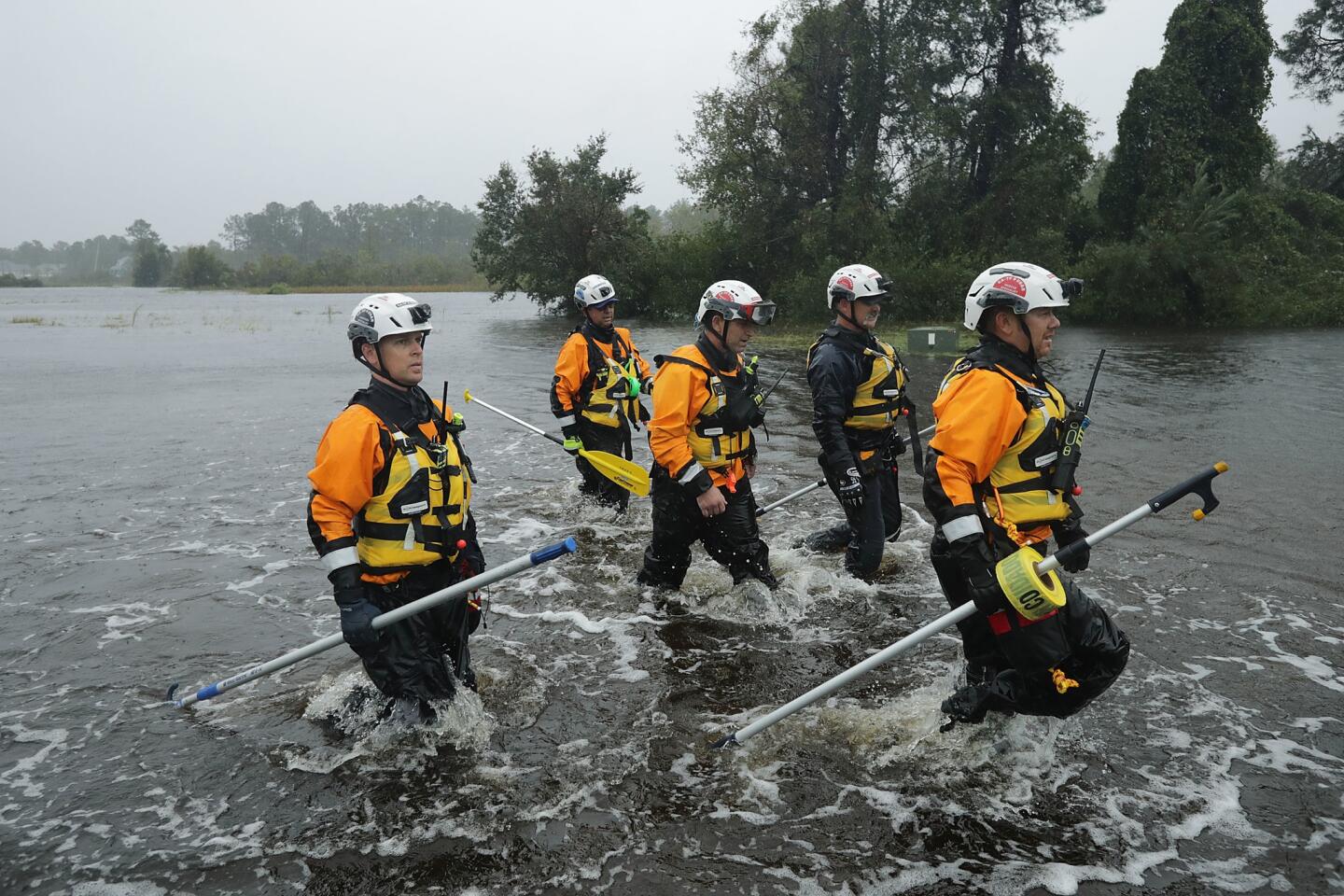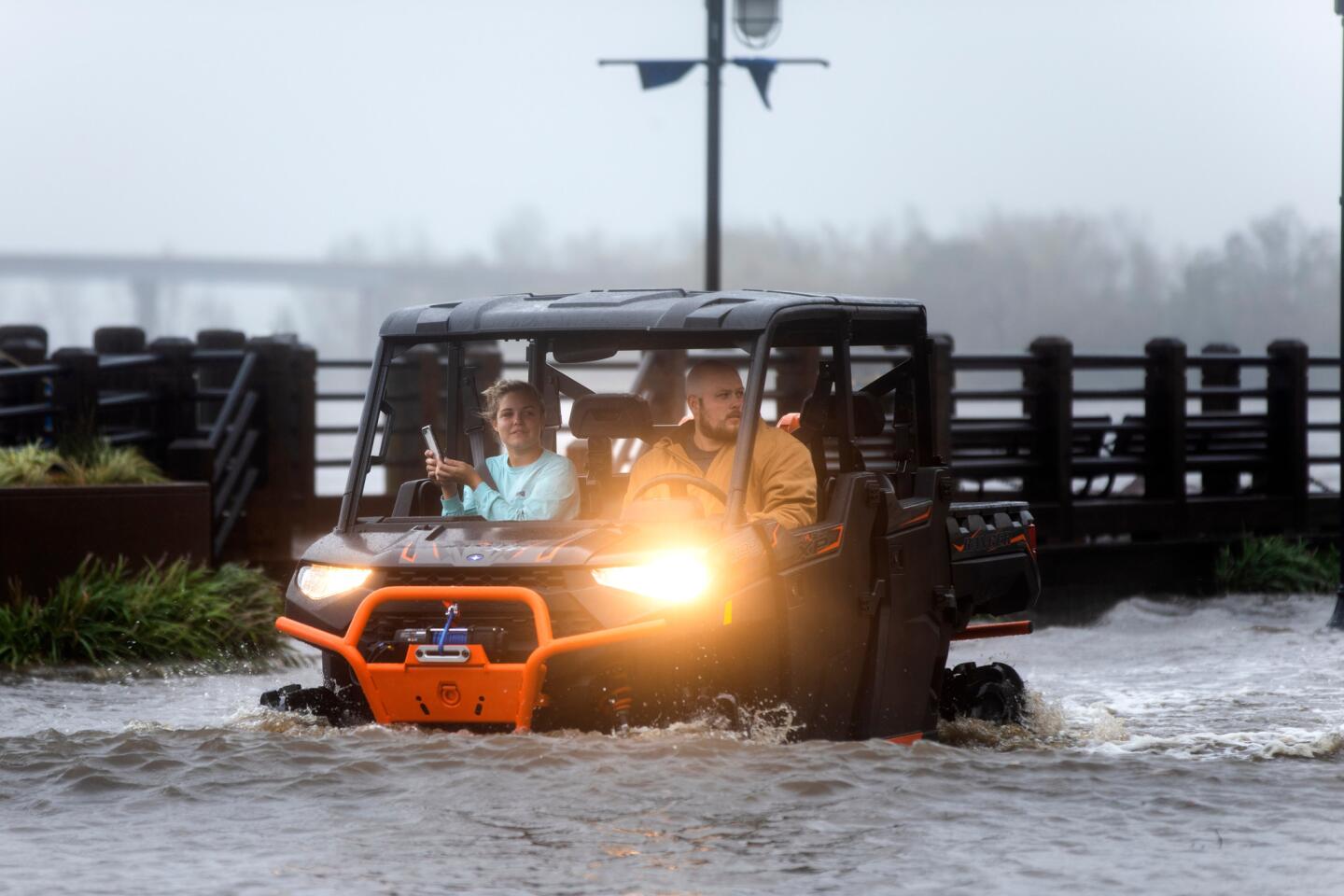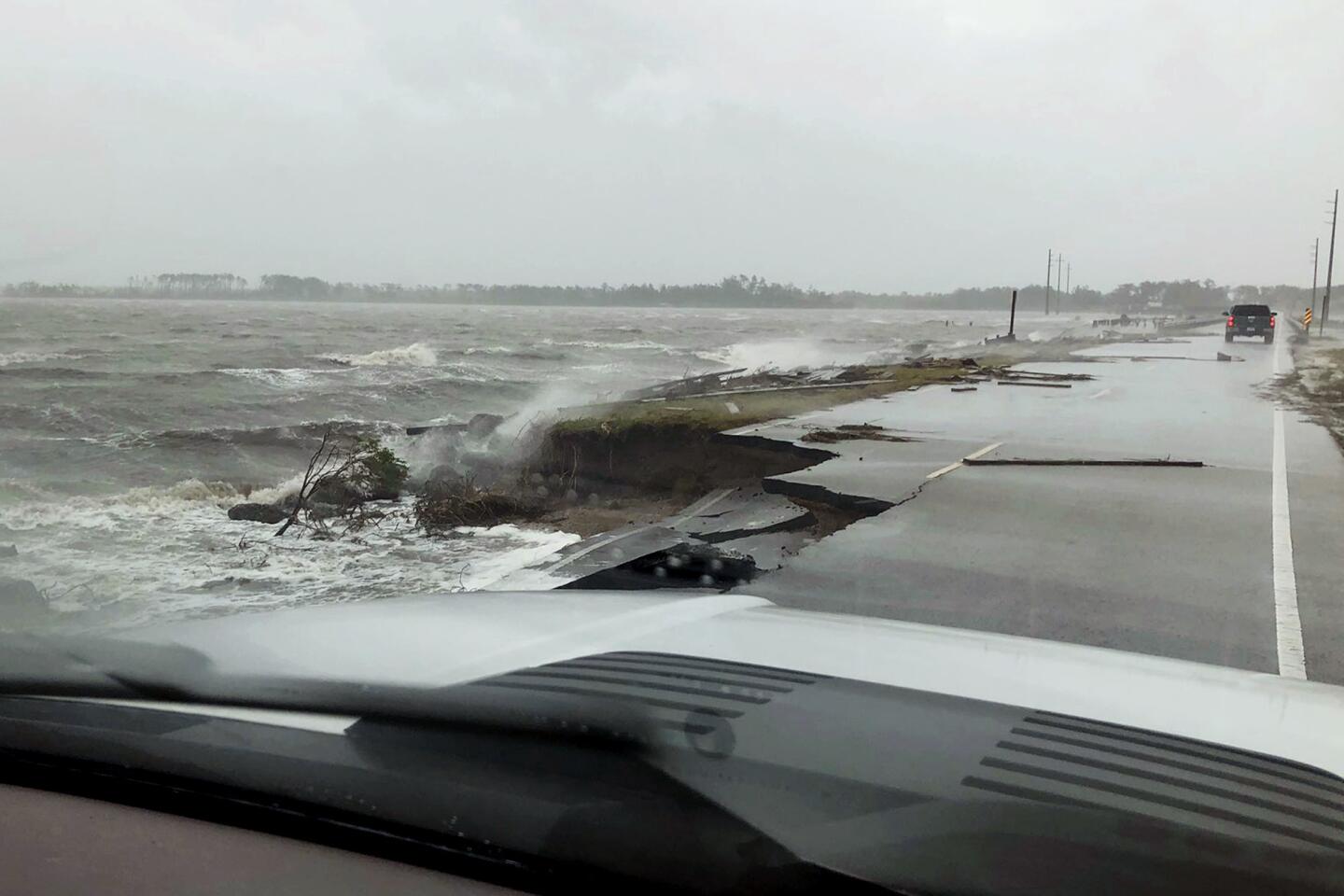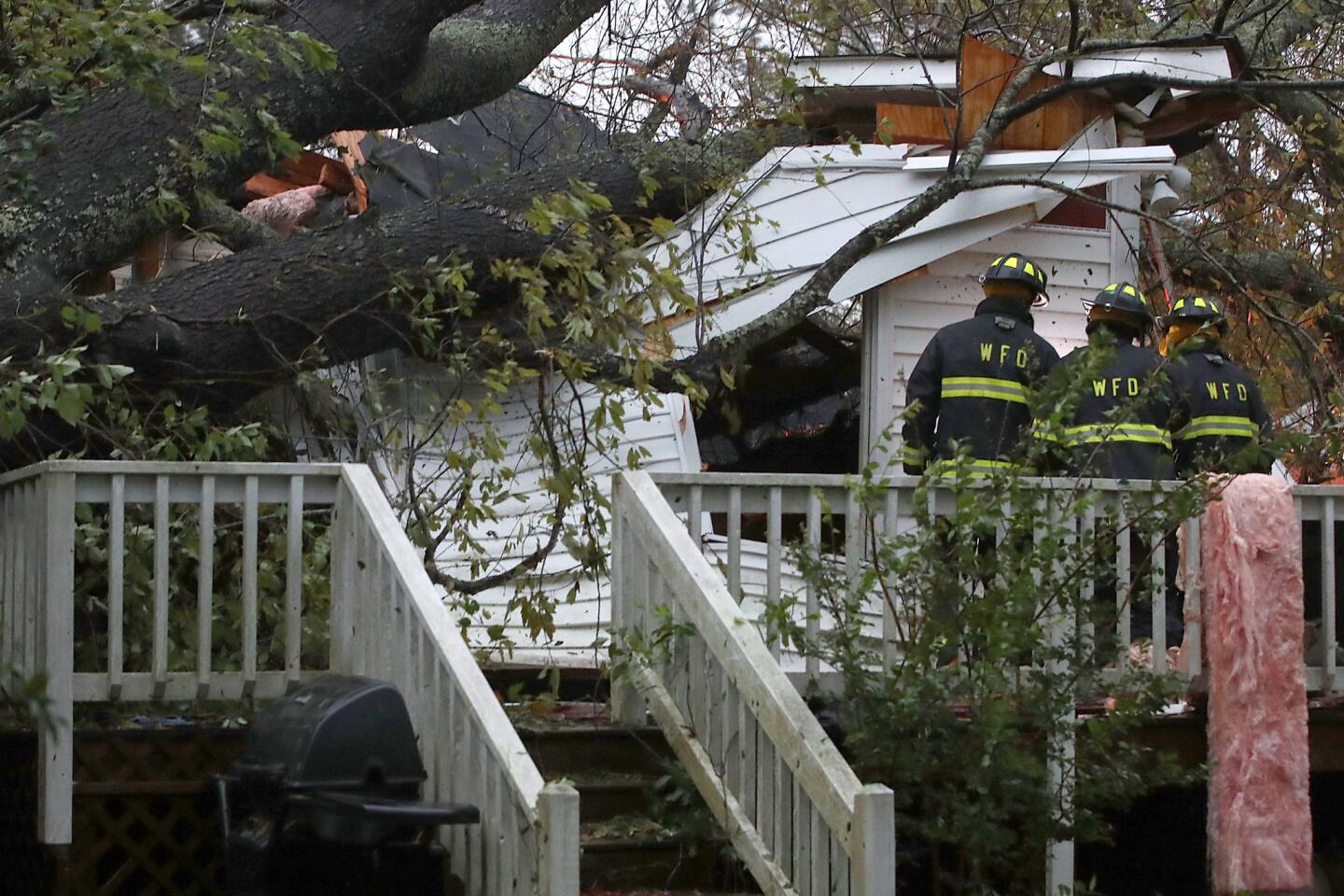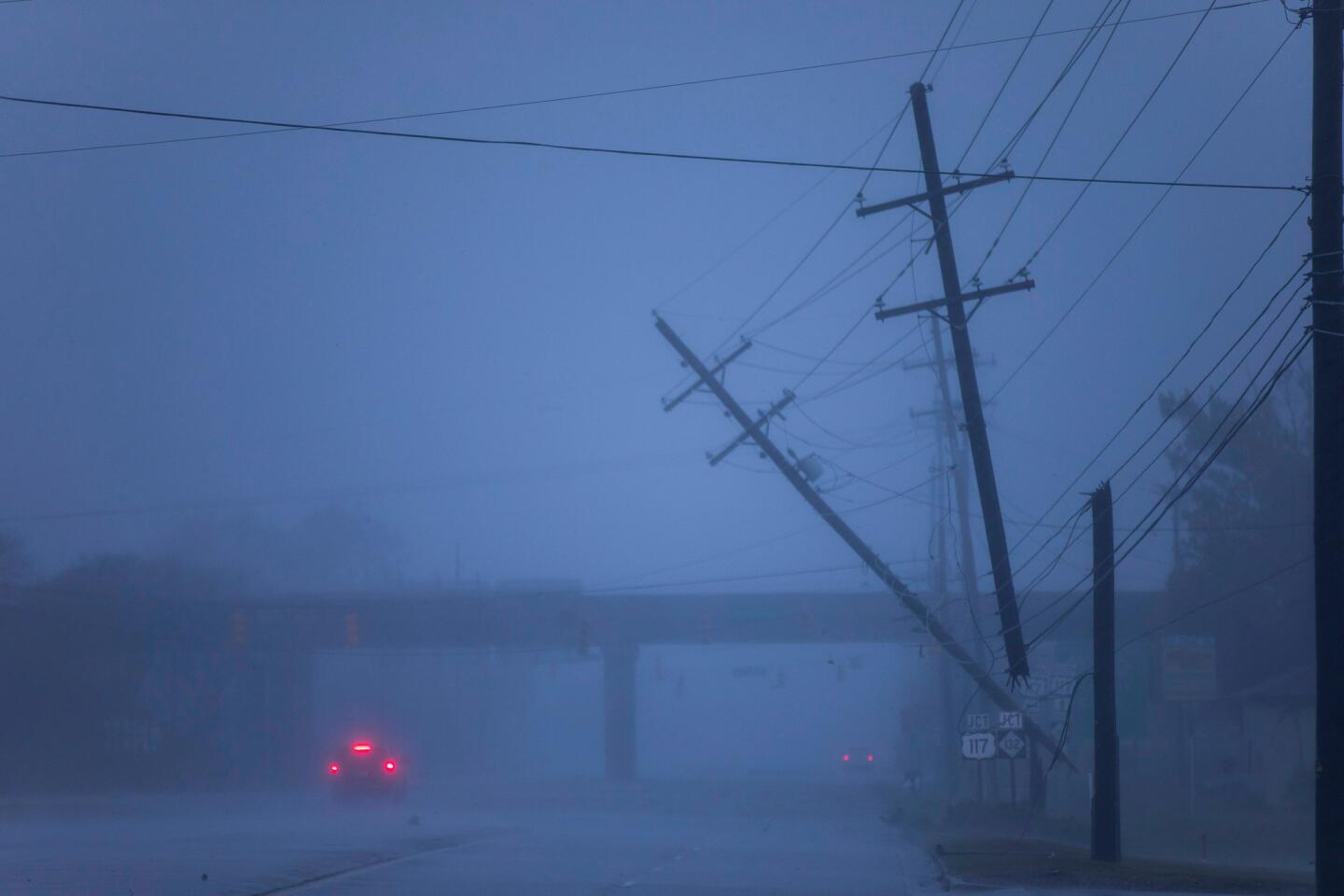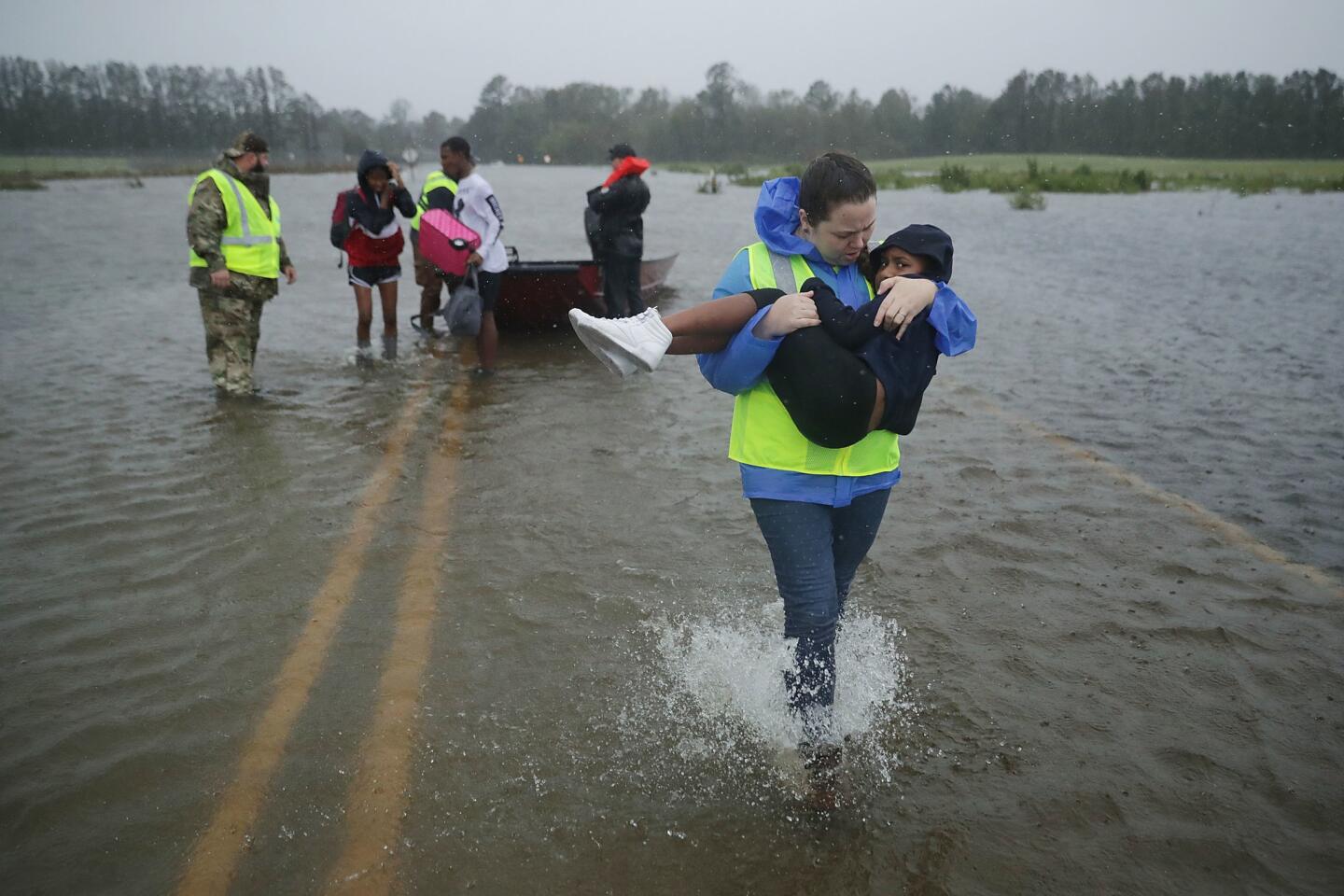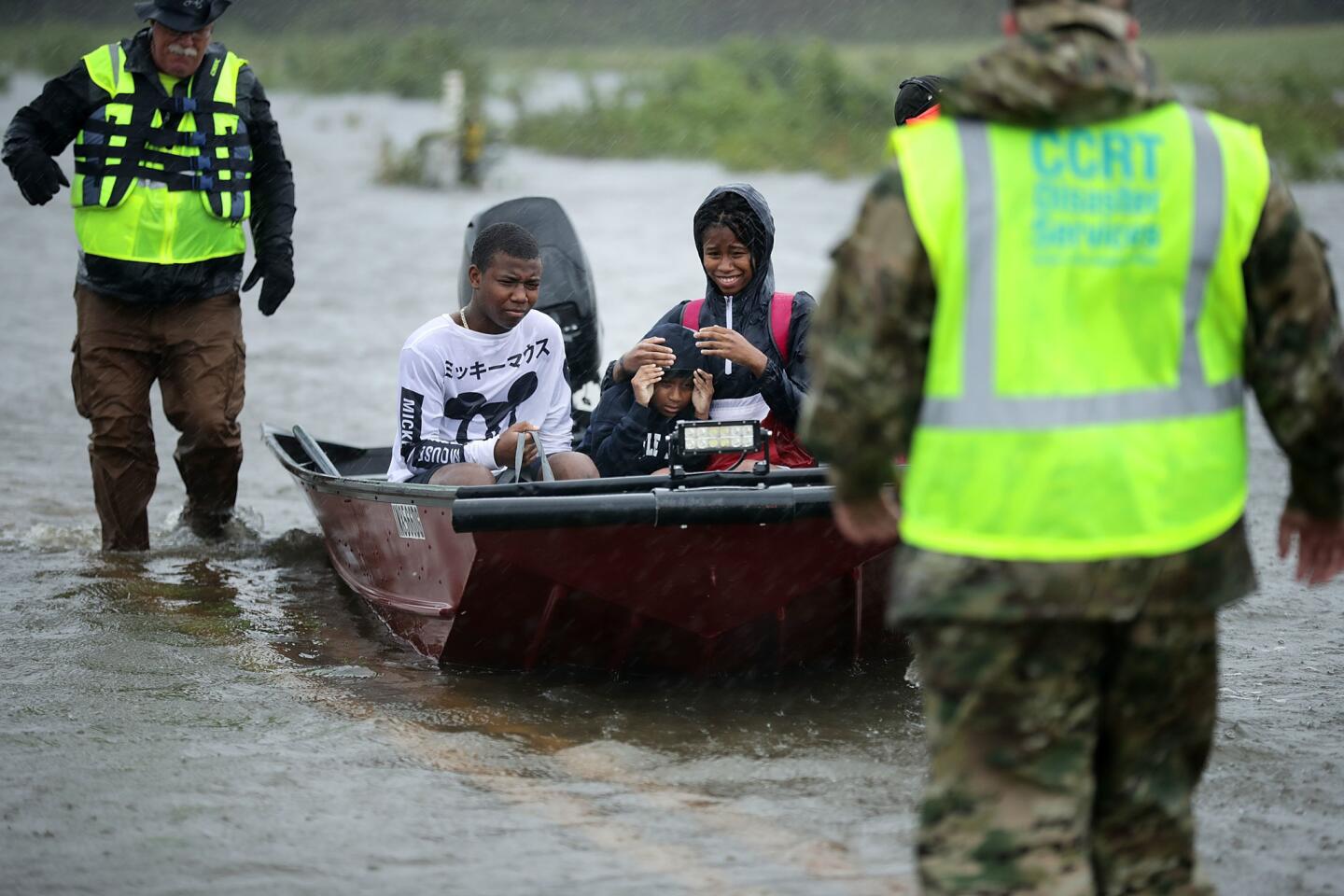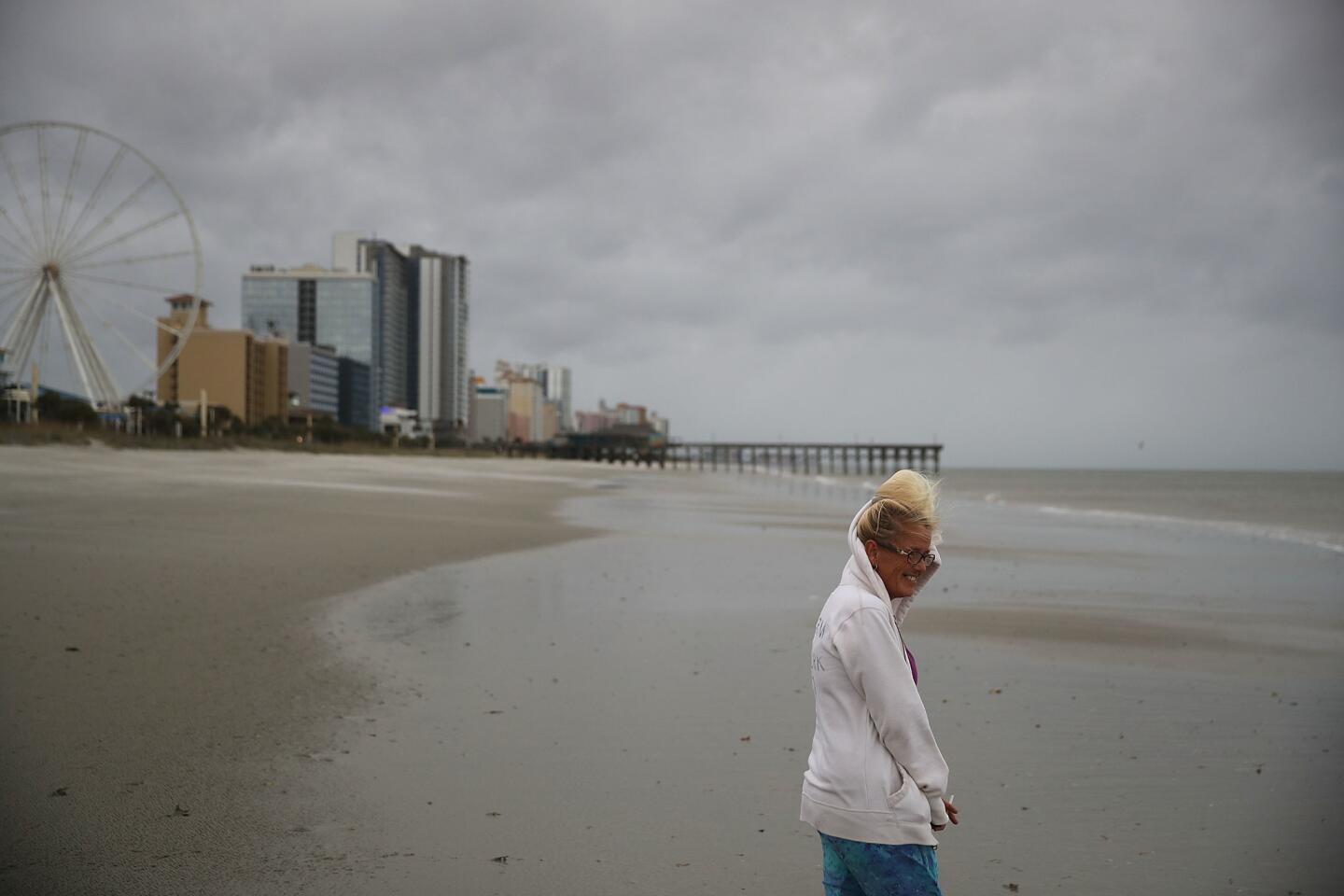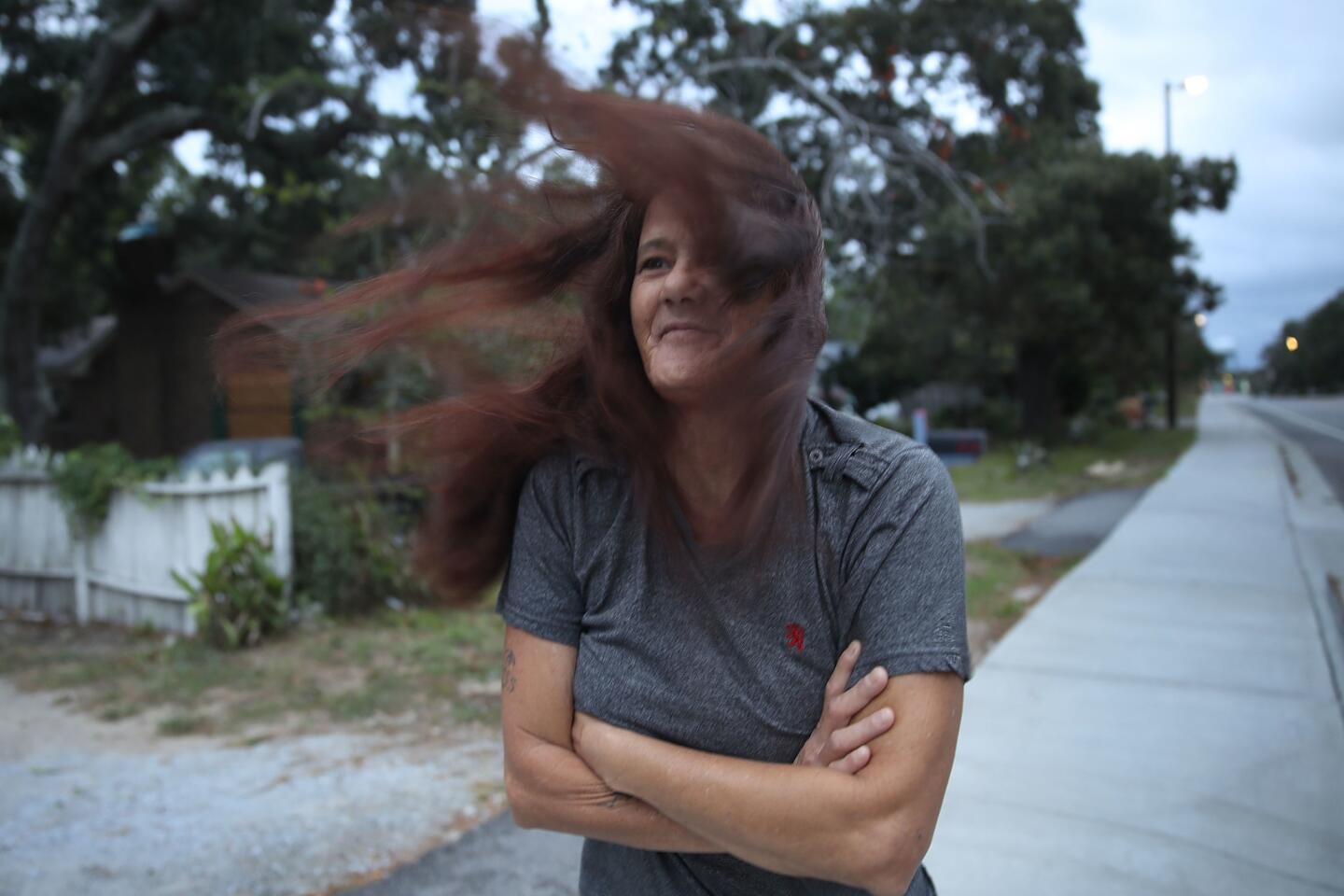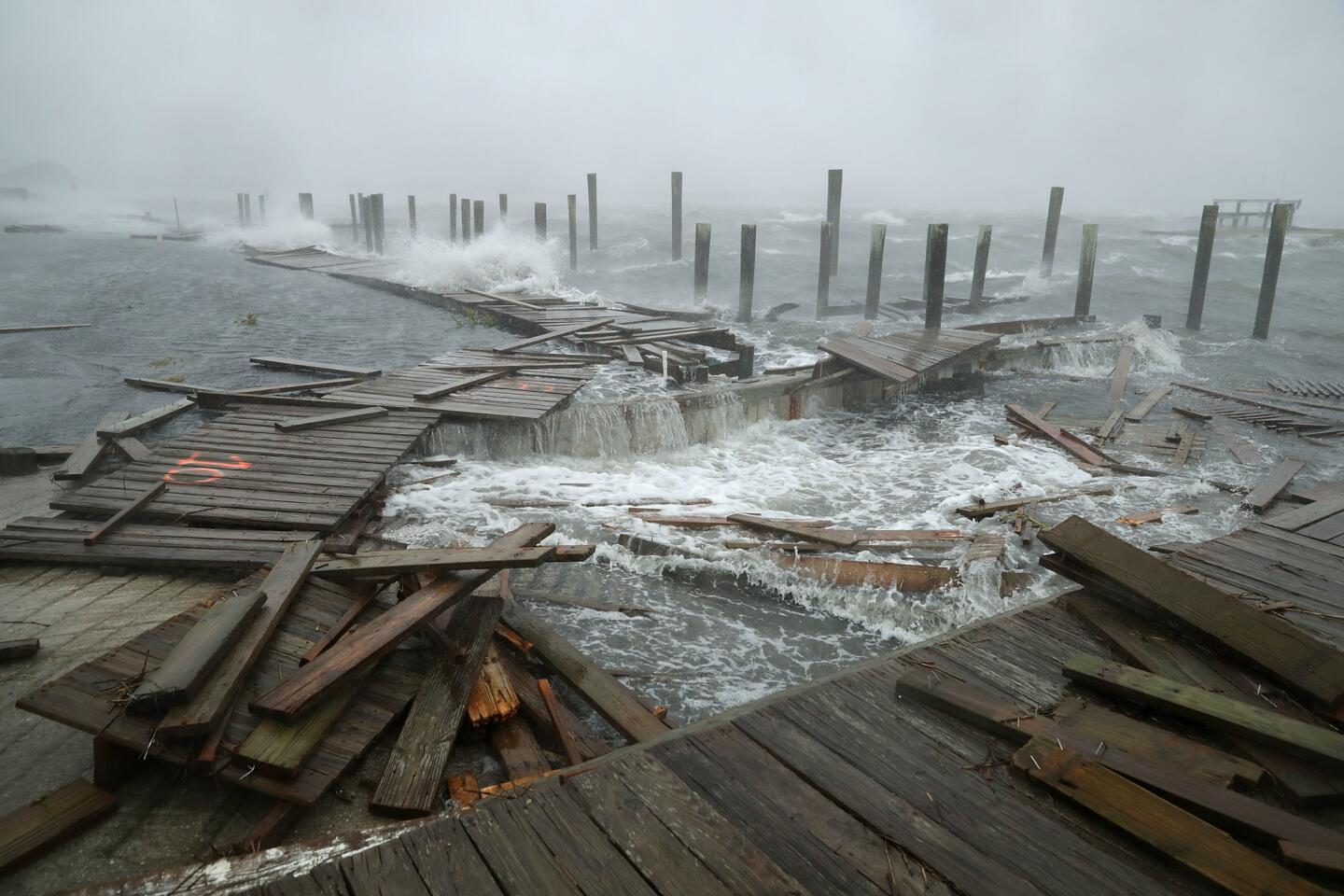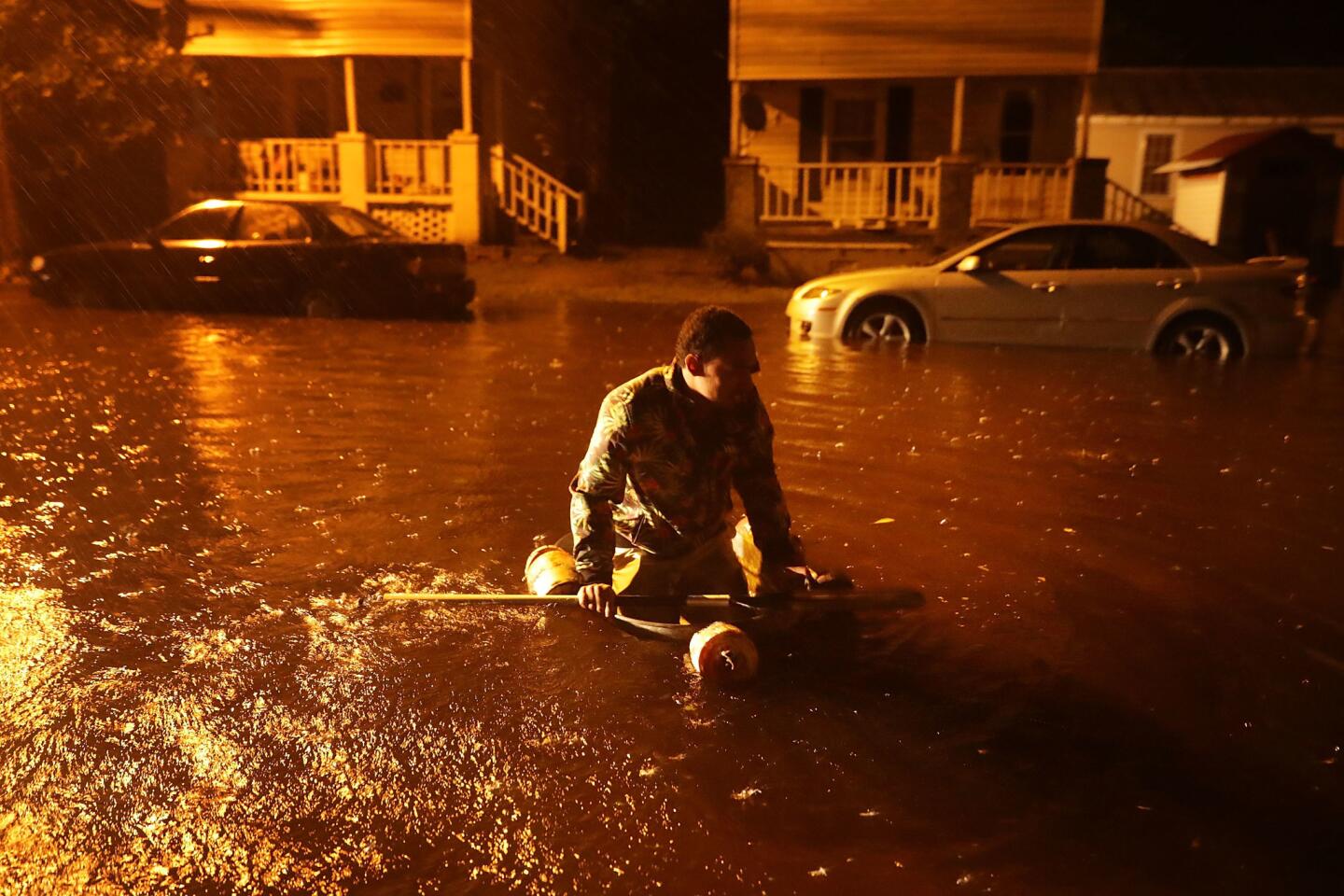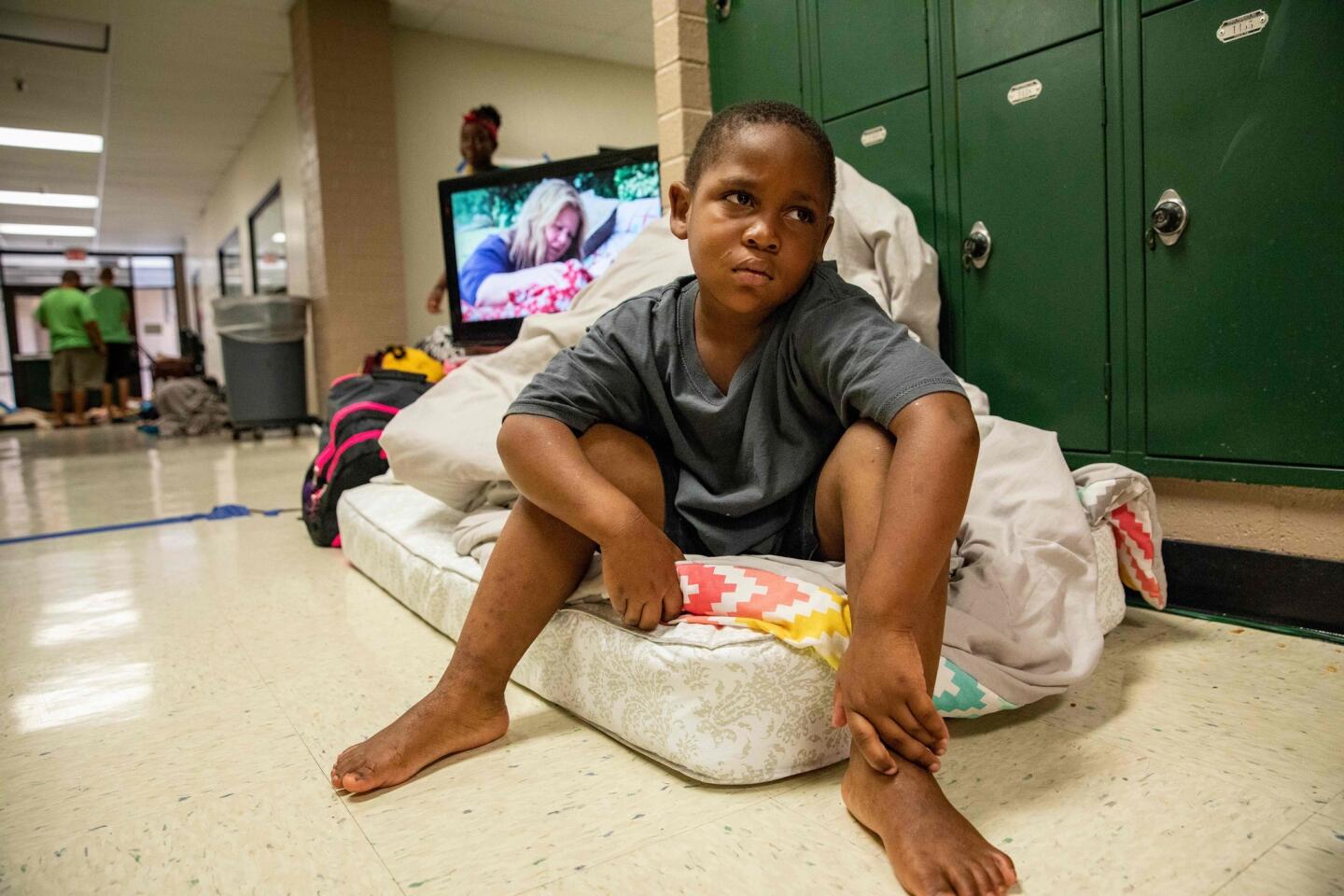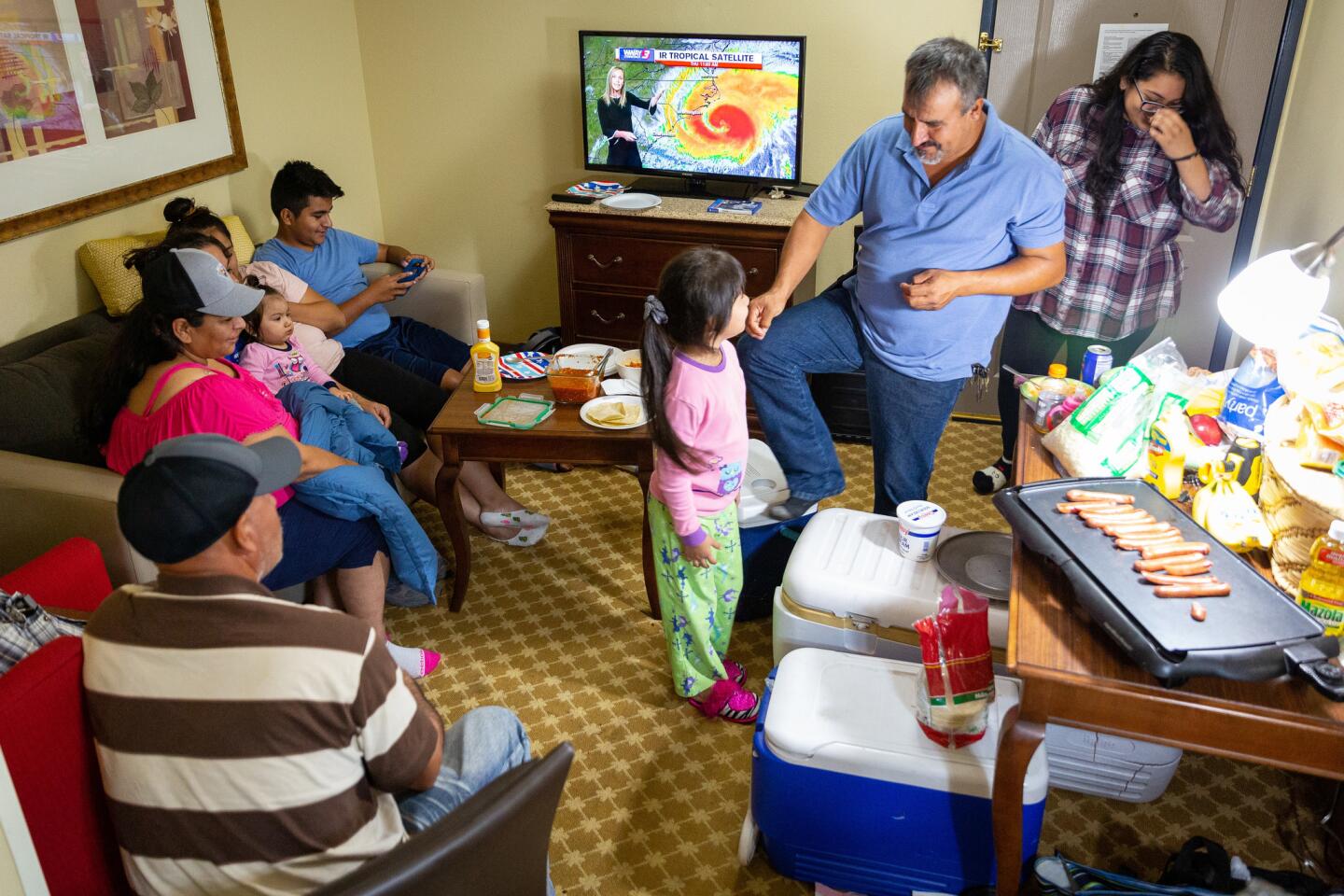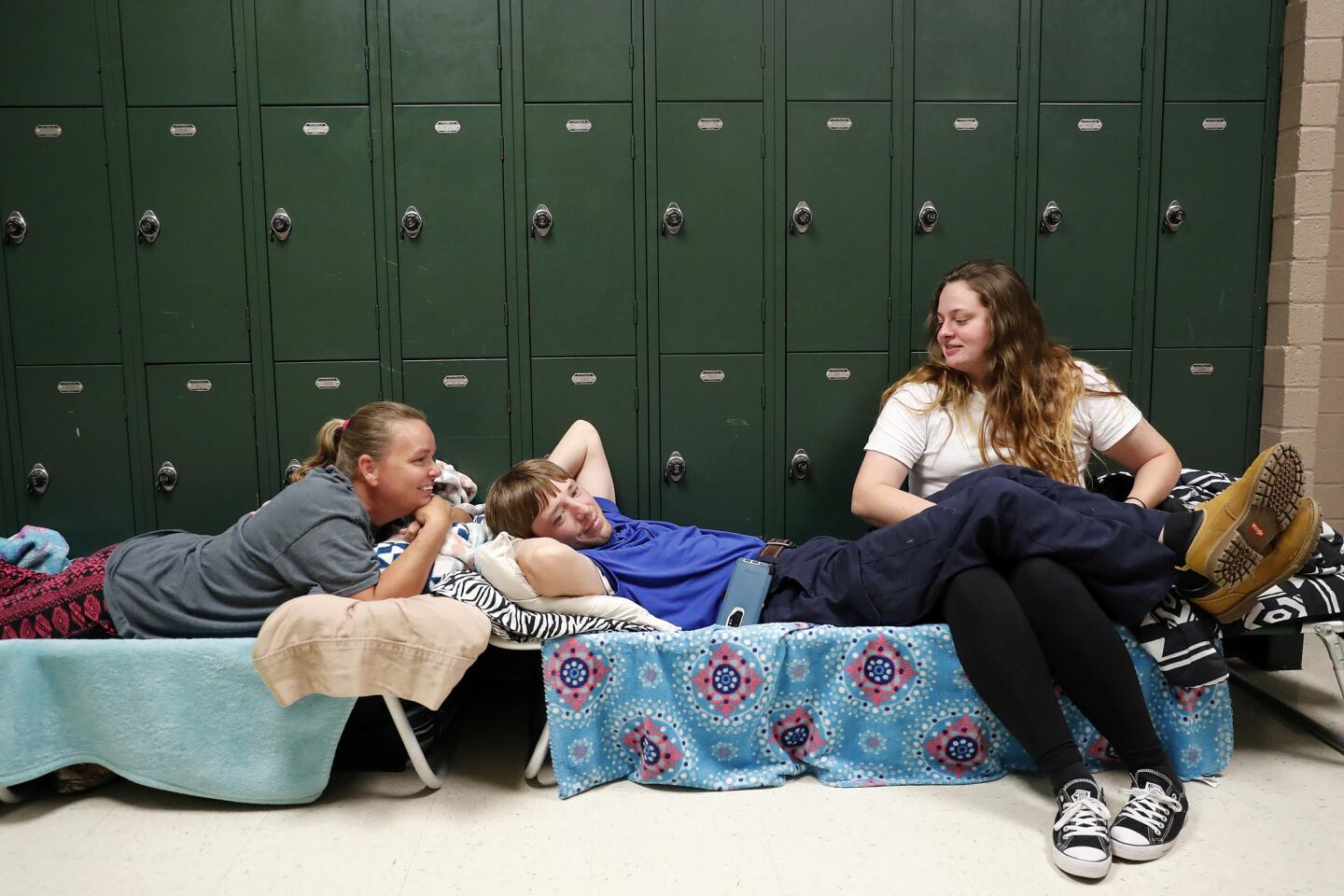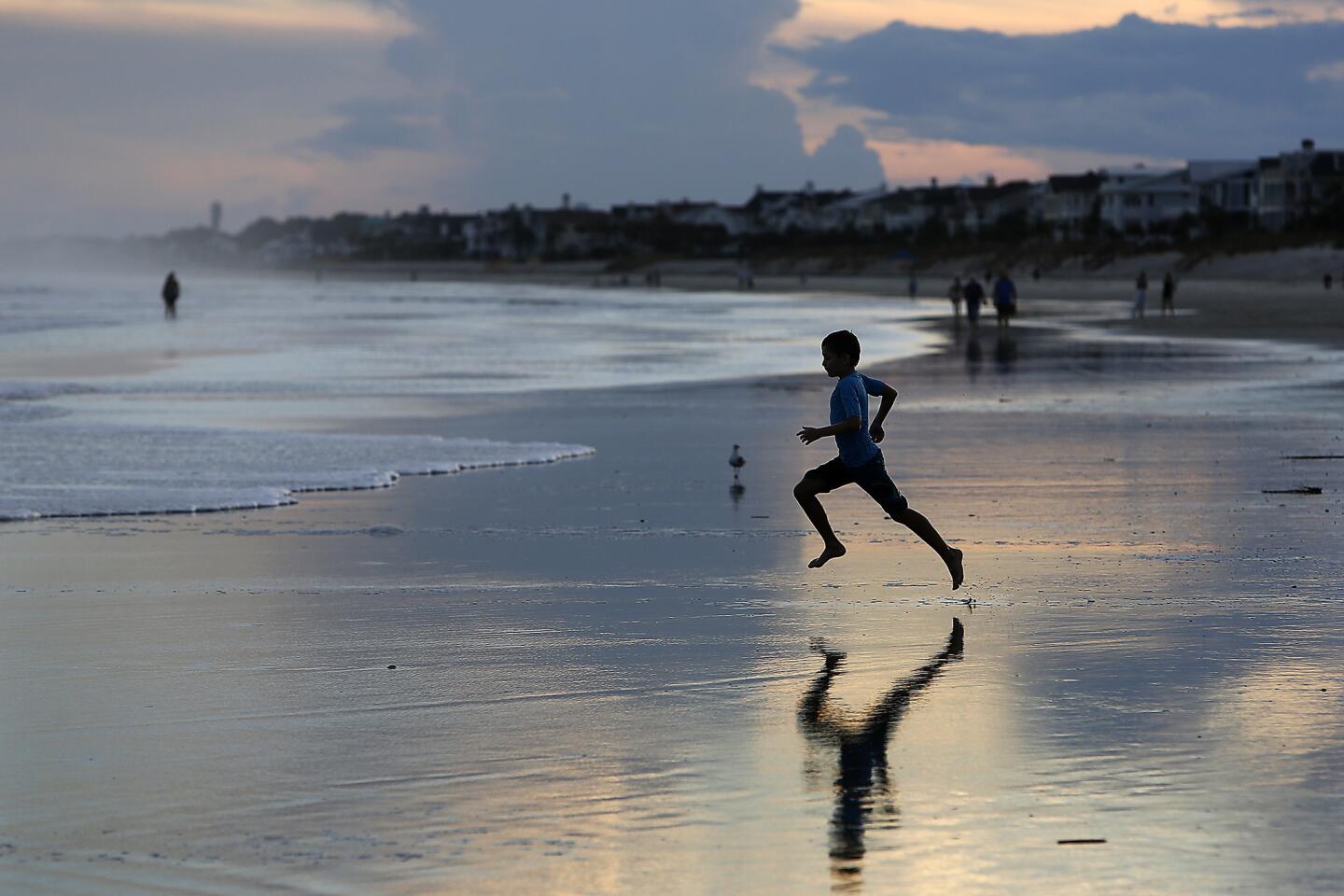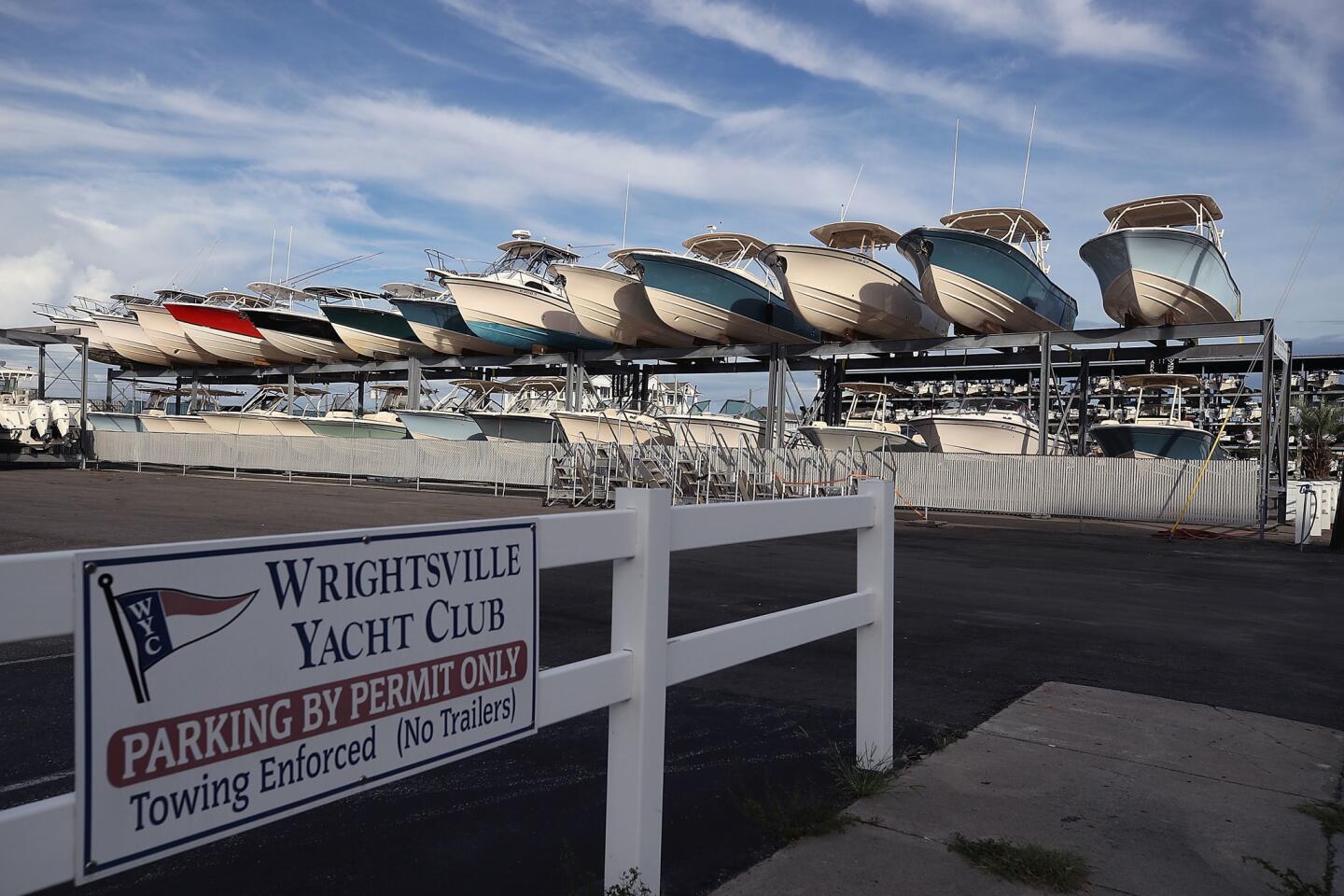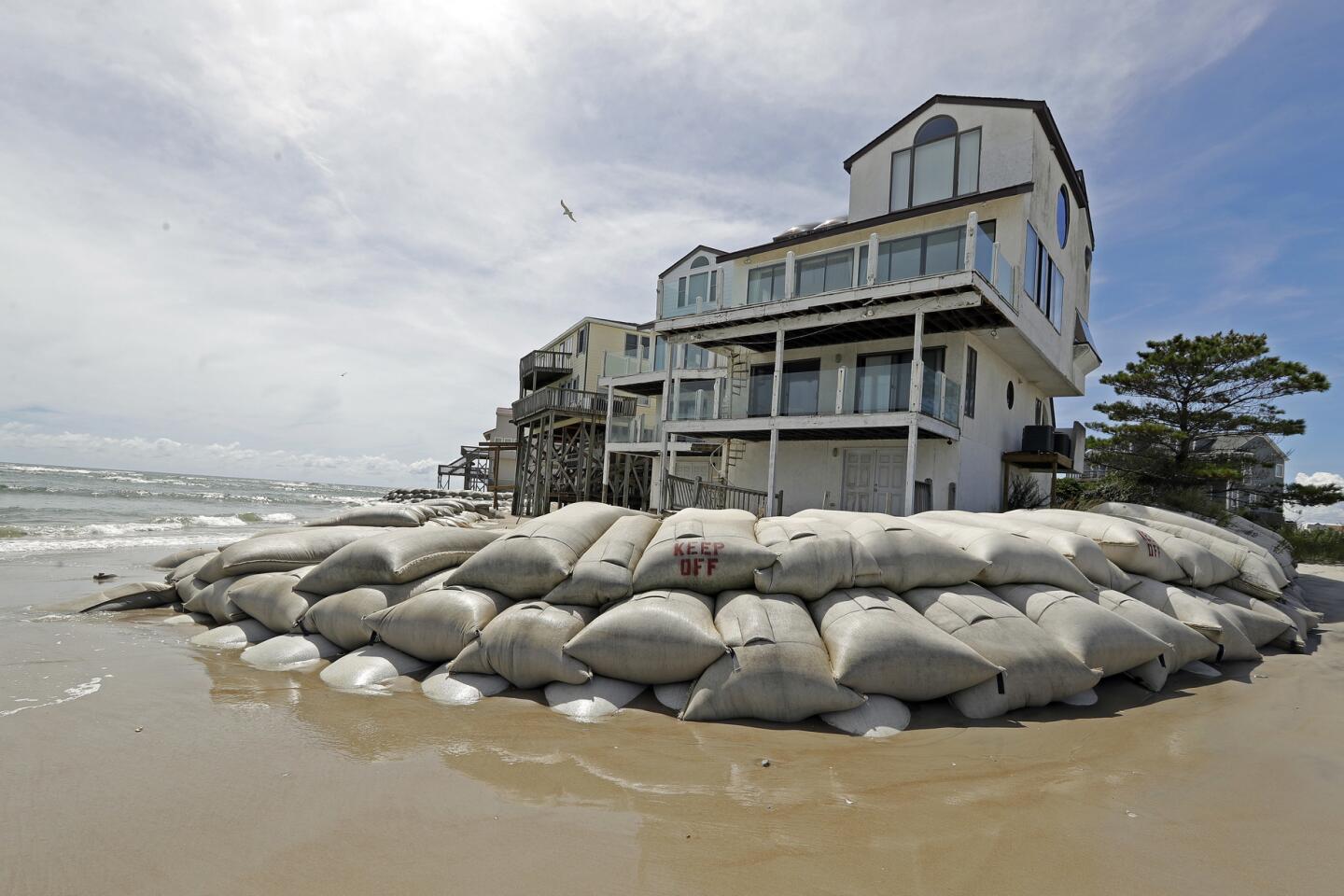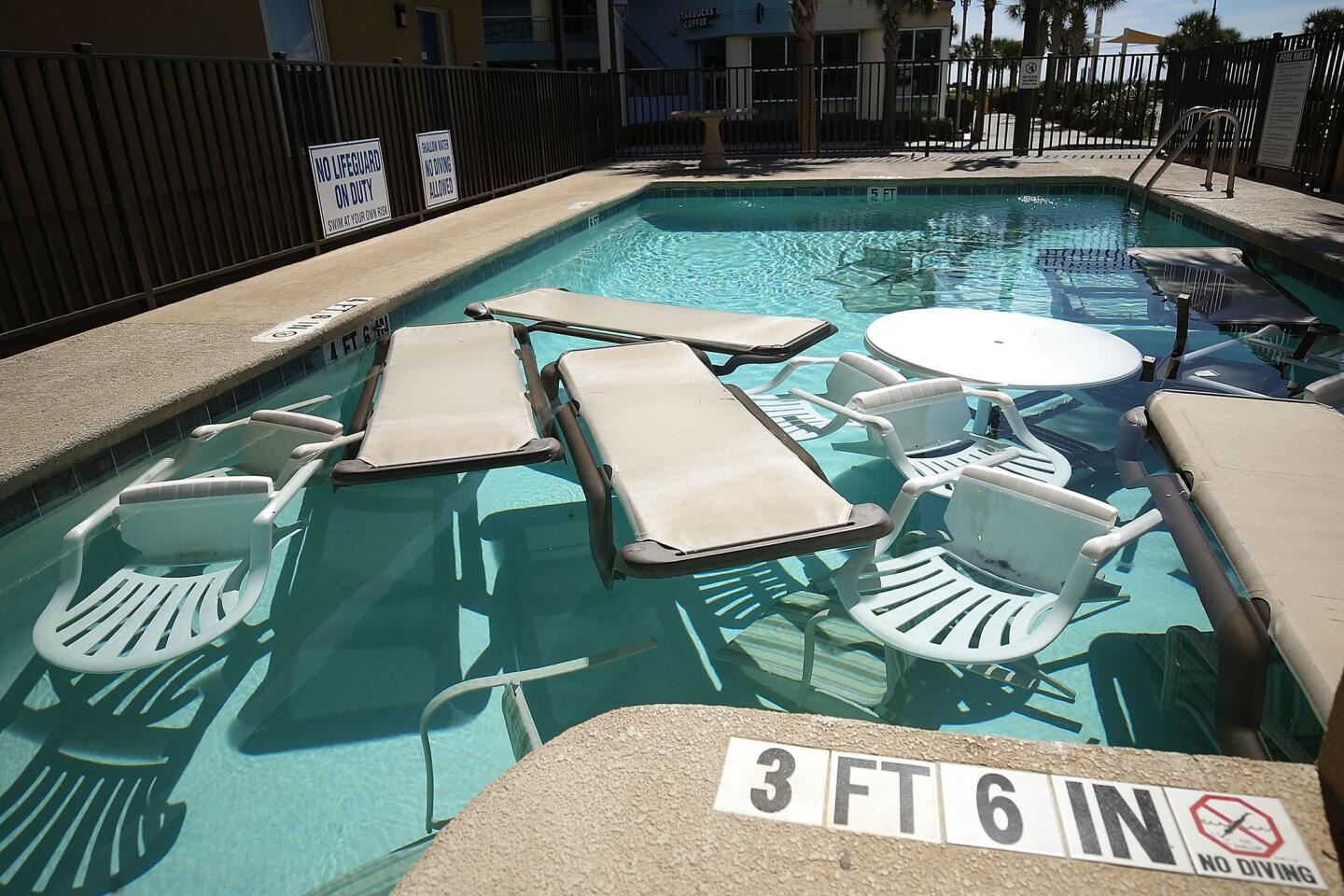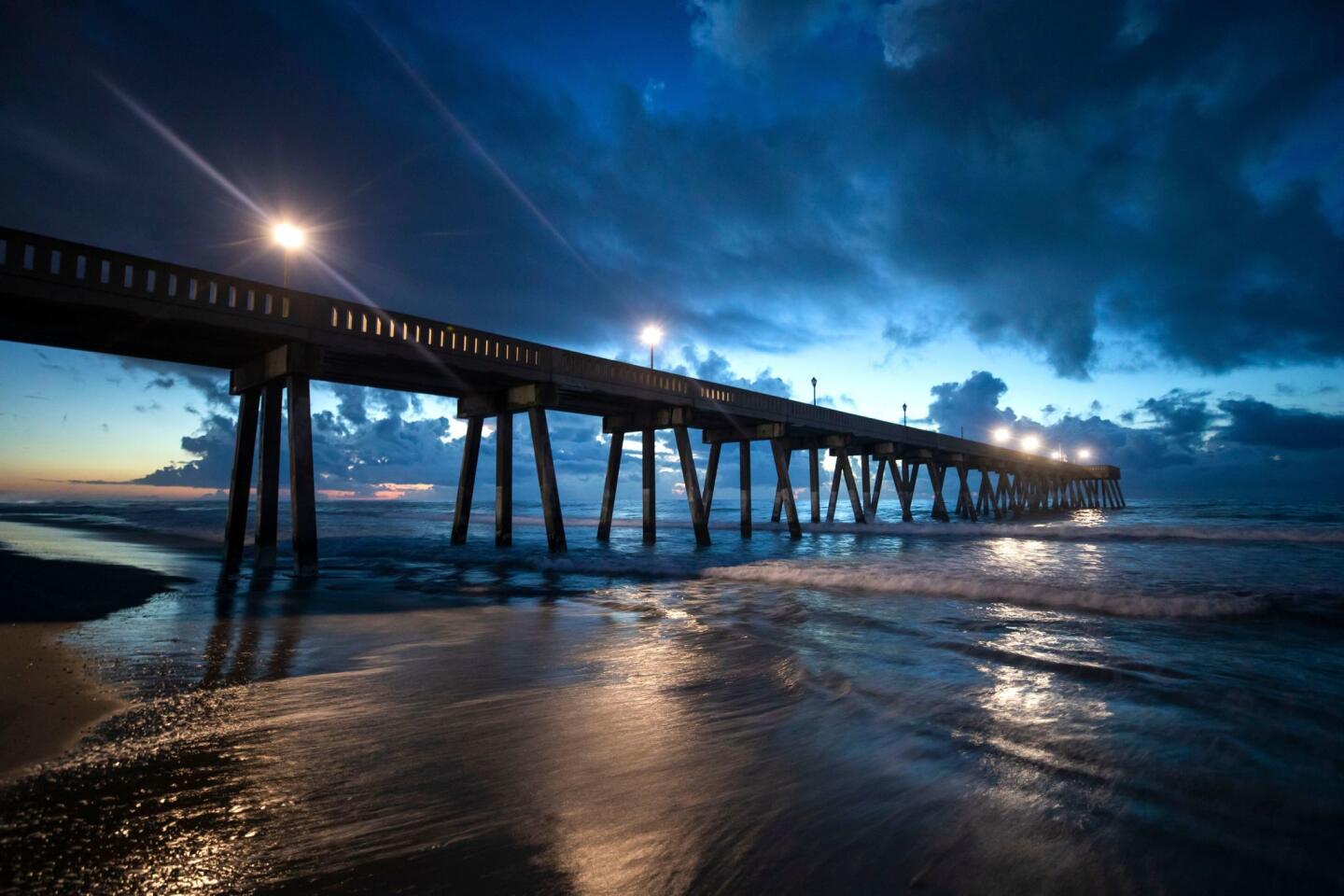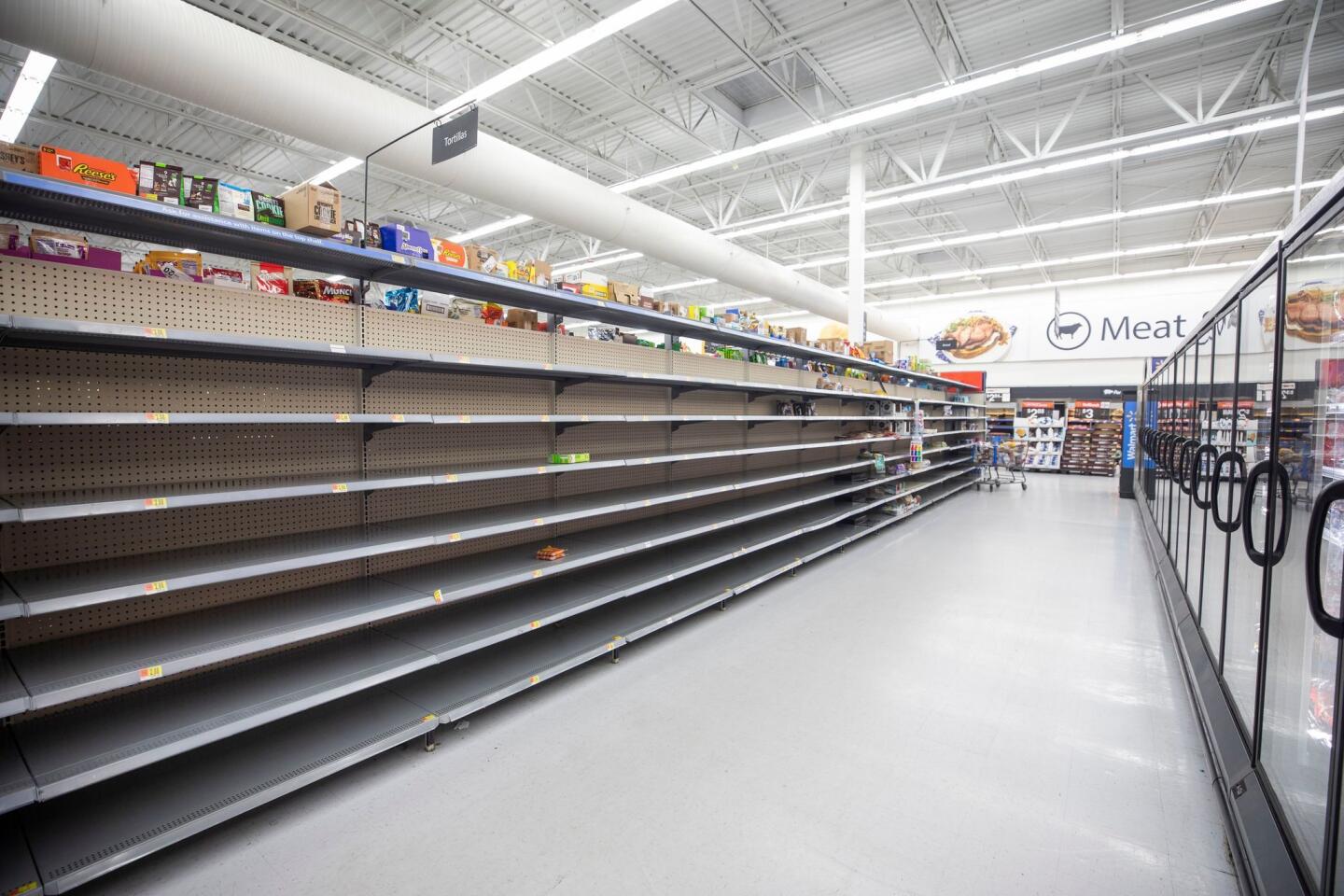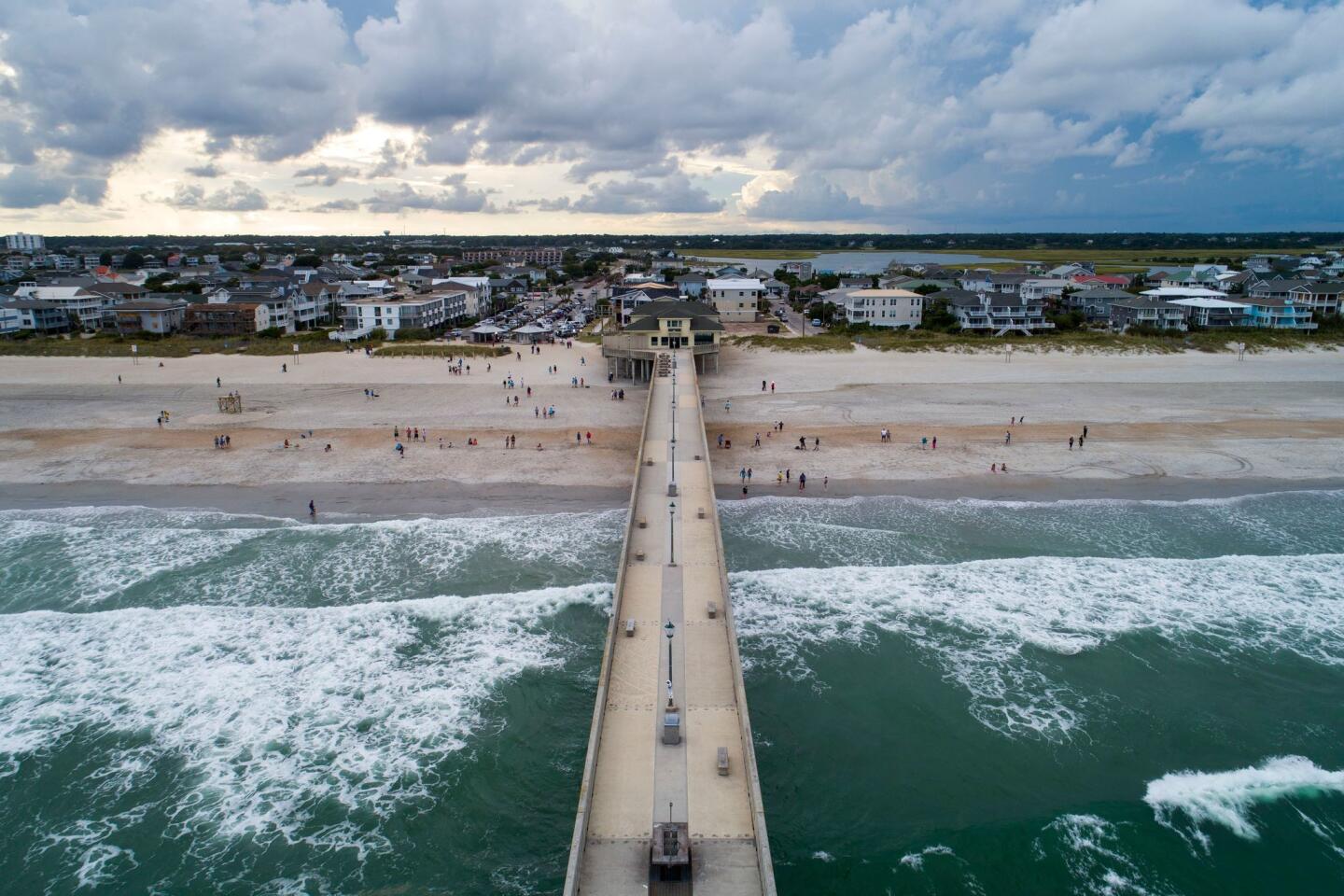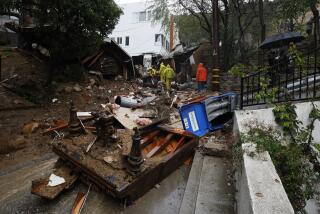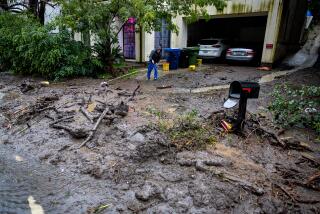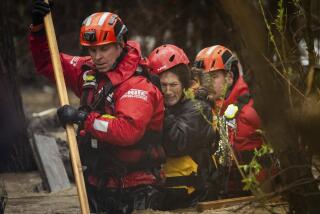Reporting from WILMINGTON, N.C. — Ocean water swamped streets and swept into buildings, while powerful winds sent a tree crashing into a home, killing a mother and her infant.
But for all its strength, Hurricane Florence was a slow-motion disaster. Deliberate and hulking as it moved Friday throughout the Carolinas, it was unhurried in its terror.
“The storm is going to continue its violent grind across our state for days,” North Carolina Gov. Roy Cooper said, calling it “an uninvited brute that doesn’t want to leave.”
Residents were urged to shelter in place, warned of extreme flash flooding and swiftly rising waters. Rescue crews rushed to save the stranded.
Police in Wilmington, N.C., said the first fatalities from the storm were the mother and child hit by a falling tree. The father of the dead infant was taken to New Hanover Regional Medical Center with unspecified injuries. A third person was killed in Lenoir County while plugging in a generator, Cooper’s office said in a statement. Pender County also reported a “medical death” during the hurricane.
Downgraded to a Category 1 hurricane, Florence inched ashore at only 6 mph, while generating sustained winds of at least 90 mph. It had lost some of its initial power over the last few days, but showed little mercy when it made landfall, overwhelming small cities like New Bern, located where the Neuse River empties into Pamlico Sound, near the midpoint of North Carolina’s Atlantic coast. After making landfall, Florence was downgraded to a tropical storm with maximum sustained winds of 70 mph. The winds were expected to gradually diminish overnight.
Pelted by sheets of rain, New Bern’s drainage ditches brimmed with debris. Power lines, uprooted oak trees and branches littered its streets. Metal signs rattled in the wind.
At a historic home on a corner near downtown, Debbie Edwards, 64, and her sister eyed the water outside through taped-up windows, while passing the time playing gin rummy.
They cleared out storm grates in the morning, hoping to prevent the rising water from reaching up and over the steps of the house that has been in the family for four decades.
“We’ve had hurricanes our entire life,” Edwards said. “Nothing like this.”
Around town, rescue teams picked up stranded residents, including a family of four whose apartment already had a knee-high waterline etched into its wall.
Some turned down the offer of a ride to a shelter. “I don’t like living with nobody,” said Reginald Nobles, 52. Nearby, toppled trash cans and garbage strewn like seaweed showed how high the water had reached. The tide was expected to rise at night.
About 45 miles north, floodwaters swamped an intersection in the town of Washington, N.C., making it impassable for everyone except a few with pickup trucks.
The metal roof of a warehouse across the street was shredded by the wind. A neighborhood grocery store flooded.
At a used car lot, rising waters had already swamped two cars. “I can live with two cars [being damaged],” said the owner, Steve Griffin, 48, who lives nearby in Bath. “I can’t live with many more.”
The wind picked up and small waves of water continued rolling in. Although flooding isn’t unusual in Washington, “this is higher than it’s ever been in this lot,” Griffin said.
Gregory Sams, 60, a retired security guard, left his second-floor apartment to look for a store selling cigarettes but couldn’t find any. Like everyone else, he wondered how high the water might rise.
“Your guess is as good as mine,” he said as a light rain fell.
Live coverage of Hurricane Florence »
Fierce winds lashed at Wilmington, a port city near the southeastern corner of the state where many of the 120,000 residents had evacuated but some remain hunkered down to ride out the storm.
About a dozen people in the breakfast area of the Country Inn and Suites stared out the window as the wind howled and trees swayed.
Outside, the sky was blank and gray, and 80 mph wind gusts tore through the trees. Debris piled up in the streets and parking lots.
1/61
A road is washed out by the rains from Hurricane Florence as it passed through the area in Fayetteville, N.C.
(Joe Raedle / Getty Images) 2/61
Flood waters from Hurricane Florence surround a house and flow along the street in Fayetteville, N.C.
(Joe Raedle / Getty Images) 3/61
A man moves his horses from rising water in Lumberton, N.C., following flooding from now Tropical Depression Florence.
(Gerry Broome / Associated Press) 4/61
Helen McKoy walks down a flooded street in her neighborhood as Florence continues to dump heavy rain in Fayetteville, N.C.
(David Goldman / Associated Press) 5/61
Homes along the New River are flooded as a result of high tides and rain from Hurricane Florence, which moved through the area in Jacksonville, N.C.
(Steve Helber / Associated Press) 6/61
Members of the North Carolina Task Force urban search and rescue team wade through a flooded neighborhood looking for residents who stayed behind as Florence continues to dump heavy rain in Fayetteville, N.C.
(David Goldman / Associated Press) 7/61
Floodwaters from Hurricane Florence rush down Cool Spring Street, inundating the St. James Church in Fayetteville, N.C.
(Jim Lo Scalzo / EPA / Shutterstock) 8/61
Erick Martinez grills chicken on the porch of his home as floodwaters from Hurricane Florence rise in the Magnolia Mobile Home Park north of Lumberton, N.C.
(Jim Lo Scalzo / EPA / Shutterstock) 9/61
A resident walks from his flooded house toward the crew of the Cajun Navy in Lumberton, N.C.
(Alex Edelman / AFP/Getty Images) 10/61
A boat pushed ashore by Hurricane Florence rests in front of a damaged home in New Bern, N.C.
(Gray Whitley / Associated Press) 11/61
Floodwaters surround buildings on Front Street in downtown Swansboro N.C.
(Tom Copeland / Associated Press) 12/61
A sign asks for prayer Friday in Lumberton, N.C., as Florence bears down
(David Goldman / Associated Press) 13/61
High winds toppled a scoreboard, knocked down a wall and uprooted trees, crushing a car, at a baseball field in New Bern, N.C.
(Chip Somodevilla / Getty Images) 14/61
A section of an exit ramp on Highway 17 was washed away when Florence hit new Bern, N.C., as a Category 1 hurricane.
(Chip Somodevilla / Getty Images) 15/61
A man makes a phone call from the front porch of his home surrounded by floodwaters in Jacksonville, N.C.
(Chuck Burton / Associated Press) 16/61
A store awning partially ripped away by high winds in Myrtle Beach, S.C.
(Alex Edelman / AFP/Getty Images) 17/61
A mother and her infant were killed Friday when a massive tree fell on their house in Wilmington, N.C. They were the first reported fatalities from Hurricane Florence.
(Andrew Caballero-Reynolds / AFP/Getty Images) 18/61
Volunteers help rescue residents and their pets from flooded homes Friday in New Bern, N.C.
(Chip Somodevilla / Getty Images) 19/61
Homes are flooded after a surge from Hurricane Florence flooded the Neuse River in New Bern, N.C.
(Chip Somodevilla / Getty Images) 20/61
The Trent River (background) overflows its banks and floods a neighborhood during Hurricane Florence in River Bend, N.C.
(Chip Somodevilla / Getty Images) 21/61
People walk through the high winds from Hurricane Florence in downtown Swansboro N.C.
(Tom Copeland / Associated Press) 22/61
Mike Kiernan takes photos of the damage to his home in Wilmington, N.C.
(Chuck Burton / Associated Press) 23/61
A woman holds a baby as she watches rising flood waters on the Cape Fear River during Hurricane Florence in Wilmington, N.C.
(ANDREW CABALLERO-REYNOLDS / AFP / Getty Images) 24/61
Members of the FEMA Urban Search and Rescue Task Force 4 from Oakland search a flooded neighborhood for evacuees in Fairfield Harbour, N.C.
(Chip Somodevilla / Getty Images) 25/61
Sam Parks walks through flooded Water Street as Hurricane Florence comes ashore in Wilmington, N.C.
(Jim Lo Scalzo / EPA/Shutterstock) 26/61
Residents drive through flooded Water Street as Hurricane Florence comes ashore in Wilmington, N.C.
(Jim Lo Scalzo / EPA/Shutterstock) 27/61
Wind and water from Hurricane Florence damages the highway leading off Harkers Island, N.C.
(Jordan Guthrie / Associated Press) 28/61
Residents look at downed trees as Hurricane Florence passes over Wilmington, N.C.
(Andrew Caballero-Reynolds / AFP/Getty Images) 29/61
Firefighters arrive at a home where a large tree fell and trapped three people in Wilmington, N.C. One man was taken out of the home in critical condition, and the condition of the others is unknown.
(Mark Wilson / Getty Images) 30/61
A boat is wedged in trees during Hurricane Florence in Oriental, N.C.
(Angie Propst / Associated Press) 31/61
Rescue workers rush a man to an ambulance after a giant tree toppled onto his house, killing two other people when Hurricane Florence came ashore in Wilmington, N.C.
(Jim Lo Scalzo / EPA/Shutterstock) 32/61
Waves slam the Oceanana Pier & Pier House Restaurant in Atlantic Beach, N.C.
(Travis Long / Associated Press) 33/61
Electric poles that snapped in half sway from their wires as Hurricane Florence comes ashore in Wilmington, N.C.
(Jim Lo Scalzo / EPA/Shutterstock) 34/61
A sign warns people away from Union Point Park after it was flooded by the Neuse River in New Bern, N.C.
(Chip Somodevilla / Getty Images) 35/61
The awning of a Shell gas station was torn off when Hurricane Florence came ashore in Wilmington, N.C.
(Jim Lo Scalzo / EPA/Shutterstock) 36/61
Volunteers from the Civilian Crisis Response Team help rescue three children from their flooded home in James City, N.C.
(Chip Somodevilla / Getty Images) 37/61
Volunteers from the Civilian Crisis Response Team help rescue three children from their flooded home in James City, N.C.
(Chip Somodevilla / Getty Images) 38/61
Linda Deem walks along the beach as winds from Hurricane Florence are felt in Myrtle Beach, S.C
(Joe Raedle / Getty Images) 39/61
Linda Stephens checks out the weather as the force of Hurricane Florence is beginning to be felt in Myrtle Beach, S.C.
(Joe Raedle / Getty Images) 40/61
Portions of a boat dock and boardwalk are destroyed by powerful wind and waves as Hurricane Florence arrives in Atlantic Beach. Coastal cities in North Carolina, South Carolina and Virginia are under evacuation orders.
(Chip Somodevilla / Getty Images) 41/61
Michael Nelson floats in a boat made from a metal tub and fishing floats after the Neuse River went over its banks and flooded his street during Hurricane Florence in New Bern, N.C.
(Chip Somodevilla / Getty Images) 42/61
A child sits on a mattress at a Hurricane Florence evacuation shelter at Conway High School in Conway, S.C.
(Alex Edelman / AFP/Getty Images) 43/61
Alejandra Rubio comforts her daughter Sarahi Ramos on Thursday in their hotel room in Wilmington, N.C., where they will wait out Hurricane Florence.
(Robert Gourley / For The Times ) 44/61
The Ramos family prepares dinner and watches the weather forecast in their hotel room Thursday night in Wilmington, N.C., where they will wait out Hurricane Florence.
(Robert Gourley/ For The Times ) 45/61
Vickie Grate, left, waits in a shelter with her son Chris, center, and his girlfriend, Sarah, after evacuating from their homes in Conway, S.C., on Wednesday.
(David Goldman / Associated Press) 46/61
Doug Lewis, left, and Chris Williams cover the windows of Knuckleheads Bar and Grill in Myrtle Beach, S.C.
(Joe Raedle / Getty Images) 47/61
A statue of Poseidon stands along the boardwalk in Morehead City, N.C., on Wednesday. Many coastal areas in Virginia and the Carolinas are under evacuation orders.
(Chip Somodevilla / Getty Images) 48/61
Sunset on the Isle of Palms, S.C., on Wednesday. Hurricane Florence has weakened slightly, but is still expected to cause potentially life-threatening storm surge and flooding.
(Mic Smith / Associated Press) 49/61
Boats are dry-docked at the Wrightsville Yacht Club on Wednesday in Wrightsville Beach, N.C.
(Mark Wilson / Getty Images) 50/61
The Lager Heads Tavern is secured on Tuesday as locals prepare for the arrival of Hurricane Florence in Wrightsville Beach, N.C.
(Mark Wilson / Getty Images) 51/61
Willy Cortright, foreground, and Erik Barfield, on roof, cover the windows of a home with plywood panels in Beaufort, N.C. Both said they planned to ride out the storm on the coast.
(Robert Gourley / For The Times) 52/61
Sandbags surround homes on North Topsail Beach, N.C.
(Chuck Burton / Associated Press) 53/61
Poolside furniture is placed in the pool of a hotel before the storm arrived in Myrtle Beach, S.C.
(Mark Wilson / Getty Images) 54/61
A mandatory evacuation is in effect in Topsail Beach, N.C.
(Mark Wilson / Getty Images) 55/61
Daniel Vaughn, left, and Frank Murphy fill sandbags while preparing for Florence in Wrightsville Beach, N.C.
(Mark Wilson / Getty Images) 56/61
Sunrise in Wrightsville Beach, N.C., two days ahead of the predicted landfall of Hurricane Florence.
(Jim Lo Scalzo / EPA/Shutterstock) 57/61
The bread aisle at Walmart is empty two days before Hurricane Florence is expected to strike Wilmington, N.C.
(Jim Lo Scalzo / EPA/Shutterstock) 58/61
Johnny Mercer’s Fishing Pier juts into the Atlantic Ocean two days before Hurricane Florence is expected to strike Wrightsville Beach, N.C.
(Jim Lo Scalzo / EPA/Shutterstock) 59/61
Chuck Ledford, left, watches “Looney Tunes” with his daughter, Misty, as they evacuate ahead of Hurricane Florence in Wilmington, N.C.
(Caitlin Penna / EPA/Shutterstock) 60/61
Jacob Whitehead, left, and Matt Jones hit golf balls into the surf as Hurricane Florence approaches in Wrightsville Beach, N.C.
(Mark Wilson / Getty Images) 61/61
People evacuate ahead of Hurricane Florence as they seek shelter at Emma B. Trask Middle School in Wilmington, N.C.
(Caitlin Penna / EPA/Shutterstock) Hurricane Florence’s glacial pace may end up increasing the storm’s danger as high winds and rainfall linger over the state.
Other threats, such as tornadoes and landslides, loom as well.
Mandatory evacuations have turned large swaths of the state into boarded-up ghost towns, and government officials have urged residents to stay off the roads.
More than 12,000 people are riding out the storm in shelters.
About 500,000 people have already lost power, and the number could reach closer to 3 million, according to Duke Energy, the state’s largest utility. The heaviest power outages are in the area around Wilmington and in the stretch of coastline between Emerald Isle and Pamlico Sound.
The U.S. Army Corps of Engineers deployed a team to the area to help restore power and protect nuclear power plants, according to a statement from the Trump administration. Nearly 4,000 federal employees are working with state and local agencies on storm response.
South Carolina was also bracing for the storm and for inland flooding that could have statewide effects. The governor implored residents to leave the coastal area as soon as possible.
“Remember this: Once these winds start blowing at that tropical storm rate, it will be virtually impossible for the rescuers to get in,” Henry McMaster said.
The region is expected to be hit hard by storm winds and persistent, heavy rain.
“It’s knocking on the door,” said Chase Dearman, a spokesman for the state’s emergency operations center. “Extensive high winds and storm surge is going to be an issue as well.”
Even in Columbia, the state’s capital and 115 miles inland, residents prepared for flooding along nearby rivers.
A mandatory coastal evacuation order left highways nearly empty in Charleston, the state’s largest city.
In Myrtle Beach to the northeast, residents made their way to rapidly filling shelters. A few holdouts sauntered on the sand by the ocean.
At Palmetto Bays Elementary, school staff cleaned and cooked for more than 400 — young families, elderly couples, immigrant workers — who lined up for a hot lunch in the cafeteria.
With four local hospitals evacuated, the American Red Cross had also set up a station at the school to care for those needing medical attention.
“The storm has time to regroup itself,” said a worried Dr. Bill Capehart, the agency’s shelter manager, who experienced Hurricane Matthew two years ago. “When it rains upstate, look out. They all drain into here, and the rivers rise so suddenly.”
Edward Sanchez, a housekeeper at a nearby oceanfront resort, was hopeful as he sat outside in sweatpants and flip-flops, trying to keep his cigarette alive in waves of windblown rain.
“At least we’re good, we’ve got a place to stay, food,” the 33-year-old said. “There are many people outside who’ve got it worse.”
Sanchez’s life has been shaped by hurricanes. He moved to South Carolina seven months ago after Hurricane Maria destroyed his home in San Juan, Puerto Rico, where he worked as a chef and bartender. During Maria, he tried to flee to a nearby shelter, but it was full.
In the storm’s aftermath, he spent more than a month living on the streets with just a backpack of possessions, begging for help from emergency officials at the convention center.
At times, he said, he wanted to die. “Nobody helped,” he recalled, his gray-green eyes tearing.
Jarvie reported from Wilmington, Hennessy-Fiske from Columbia, S.C., and Megerian from Washington, N.C. Times Staff Writer Corina Knoll in Los Angeles contributed to this report.
UPDATES:
5:20 p.m.: This article was updated with more details about fatalities, details about residents at shelters.
1:45 p.m.: This article was updated with details about fatalities and statements by the governors of North Carolina and South Carolina.
11:35 a.m.: This article was updated with details from Columbia, S.C.
10:40 a.m.: This article was updated with details about a shelter in Myrtle Beach, S.C., and the federal response.
8:50 a.m.: This article was updated with details from Washington, N.C.
6 a.m.: This article was updated with a comment from the mayor of New Bern, N.C.
5:10 a.m.: This article was updated with the storm making landfall.
This article was originally published at 4:05 a.m.

